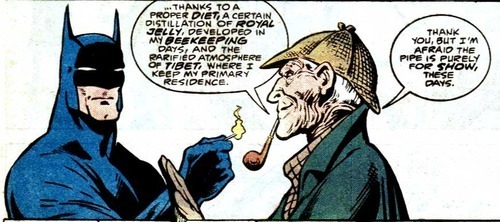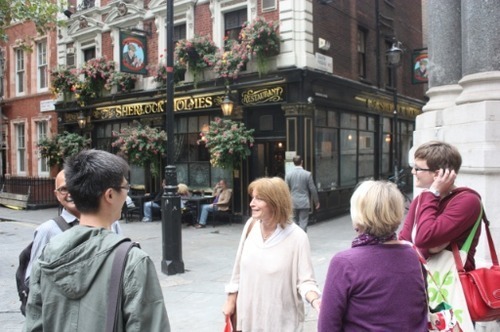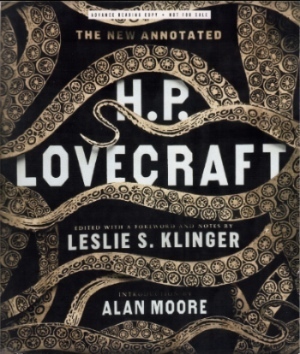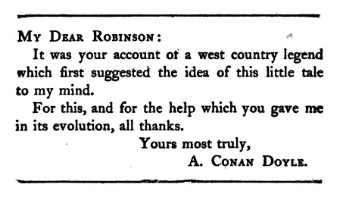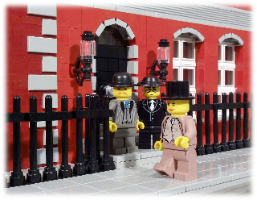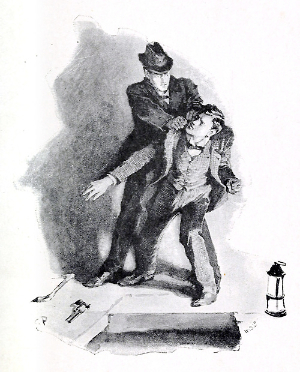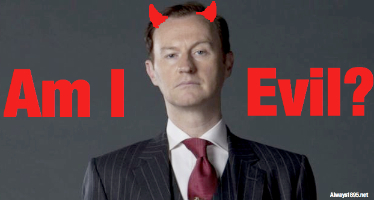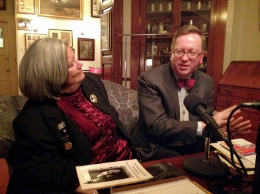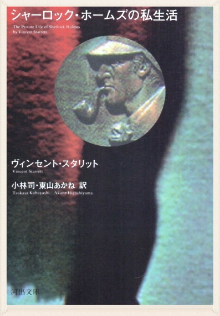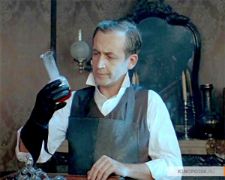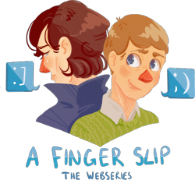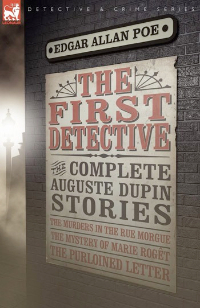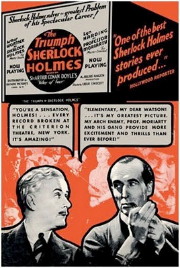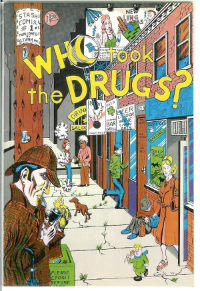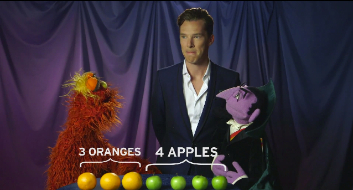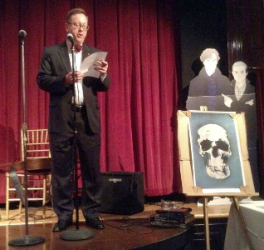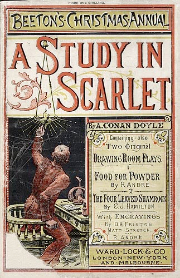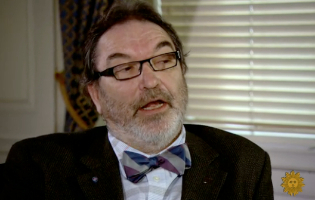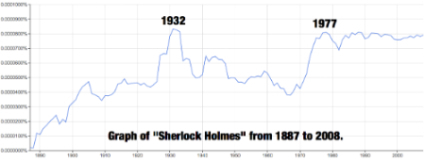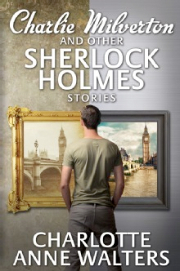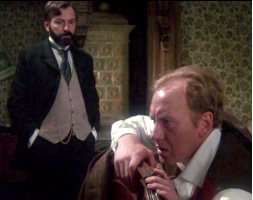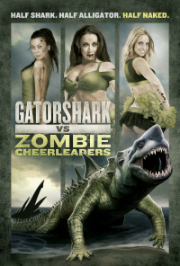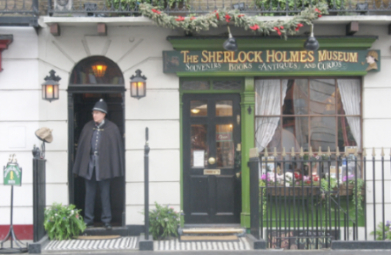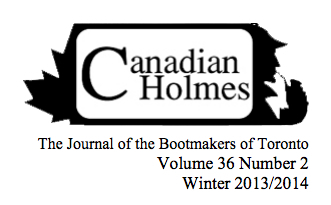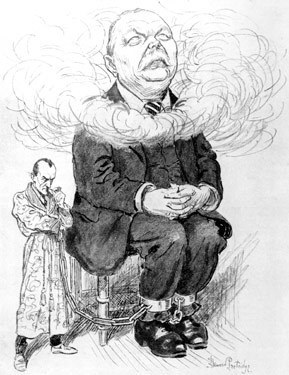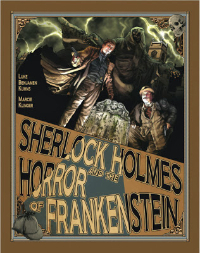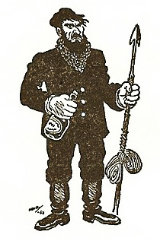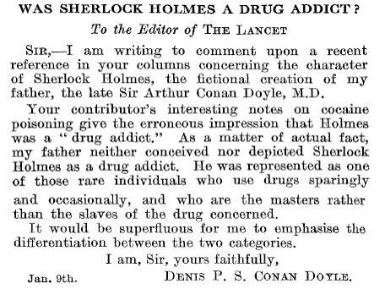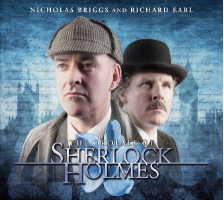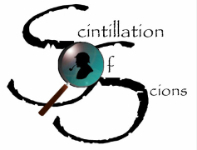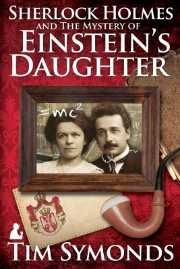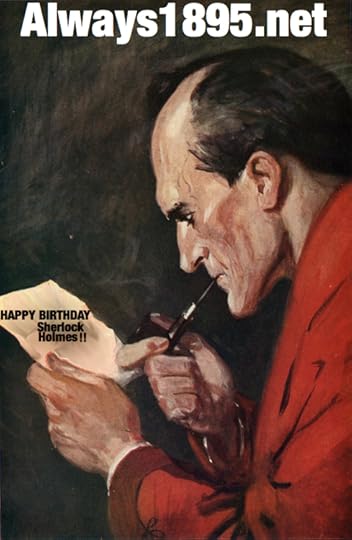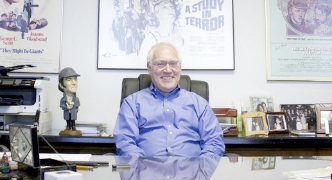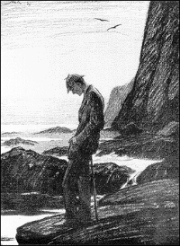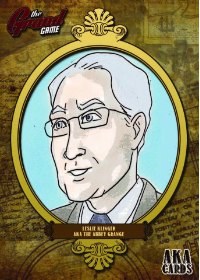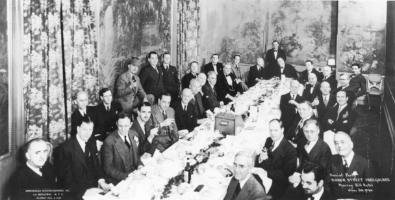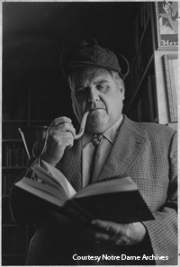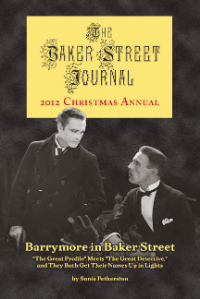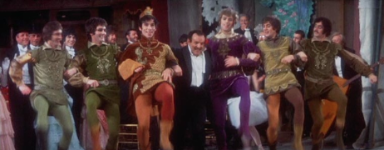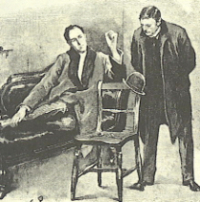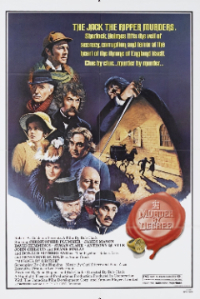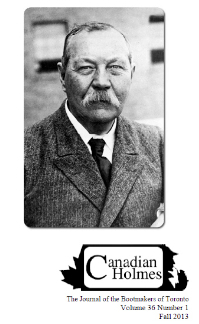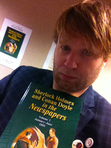Matt Laffey's Blog
October 19, 2014
Weekly Sherlock Links Compendium (October 1 - October 19, 2014)
Always1895.net is back…..
William Gillette's 1916 film Sherlock Holmes has been the stuff of Sherlockian legend for over 100 years - assumed lost since c. 1918, the film was comprised of the only motion picture recording of William Gillette performing his most famous role, that of the Great Detective, honed on the stage for decades. Then one magical day in early 2014 a remarkable discovery was made deep in the vaults of the Cinémathèque Française. On October 1, 2014 the Cinémathèque Française and the San Francisco Silent Film Festival (SFSFF) issued a joint press release announcing the recent discovery of a complete nitrate duplicate negative of the ‘lost’ 1916 film entitled Sherlock Holmes. Restoration of the film is being handled by the SFSFF and Cinémathèque Française, and according to the SFSFF, “the European premiere will take place at the Cinémathèque Française’s festival of film restoration, Toute la Mémoire du Monde, in January 2015. The American première will take place at the San Francisco Silent Film festival in May 2015.” In less than a year William Gillette and Sherlock Holmes will become as one again. Truth be told, Sherlockian news doesn’t get more exciting than this!
Not long after the joint press release announcing the historic re-discovery of Gillette’s mythical performance, Scott Monty of I Hear of Sherlock Everywhere broke the news to an unsuspecting Sherlockian public, igniting a furry of excitement and disbelief. Recapping events thus far, Monty also managed to secure an exclusive interview with lead film restorer and SFSFF Board President Robert Byrne. When IHOSE asked if Byrne and his colleagues learned anything about the film that wasn’t previously known, Byrne replied:
"We are learning that it is a very good film! What a disappointment it would have been to have discovered the holy grail only to find that the acting was hammy and the settings were cheap. Quite the contrary! I predict that audiences are going to be mesmerized with the final result."
It’s been half a month since the Sherlockian world found out that this historical treasure, long thought lost, will soon see the light of day for the first time in over 100 years. Not surprisingly Twitter, the Sherlockian blogs and even mainstream media outlets have been ablaze with heady talk of the Gillette lost film miracle. A sampling of responses and reactions can be found at every level of the Internet: Roger Johnson of the Sherlock Holmes Journal; Alistair Duncan of Doyleockian who speculated that this discovery “also means that there is one less ‘lost’ film and renewed hope that other rediscoveries will happen;” and even the New York Times - ArtsBeat.
For a tiny hint of what we can expect from William Gillette as Sherlock Holmes, here are two very famous audio tracks which capture a few minutes from one of Gillette’s many Sherlock Holmes theatrical performances: William Gillette as Sherlock Holmes - Part 1 and William Gillette as Sherlock Holmes - Part 2. Enjoy!
[Original promotional poster for Sherlock Holmes (1916) directed by Arthur Berthelet and produced by the American studio Essanay.]
The Baker Street Babes reach the masses via advanced sonic transmission technology (ie. podcasts) in order to promote their unique perspective on Sherlockian culture. They have also hosted multiple events such as the Daintiest Thing Under a Bonnet which raises funds for The Wounded Warrior Project as well as, from time to time, challenging the status quo when the necessity outweighs the potential hullabaloo that rocking the proverbial boat might create. And they do all this and more for the love of the game, Sherlock Holmes and the unique fan culture that surrounds the Sherlockian world — but what happens when equipment begins to deteriorate, computer hosting costs increase and new members need to be outfitted with at least a basic technological set-up in order to participate in the regular production of the show?
I suppose the Babes, roughly eleven in number, could have chosen the Baader-Meinhof route and ‘liberated’ the funds needed to carry on their activities, but I suspect lessons gleaned from tales like “The Red-Headed League” persuaded this world-wide syndicate of talented and dedicated Sherlockians to seek slightly more legal means of bankrolling their aims. And what munitions precisely do the Babes need to carry on the good fight? According to their post on Indiegogo - a site similar to Kickstarter but more modest in scope - the equipment most needed to sustain and upgrade their current podcasting situation are…microphones and digital recorders (Were you expecting enriched Uranium 235?).
I strongly encourage you to check out the cost breakdowns on their Indiegogo page to see precisely how donated money would be spent - but basically they are asking for a total of $2290 which would be used to equip all 11+ members with decent microphones and digital recorders so the Babes can continue producing their unique and sincere Sherlockian podcasts. Of course in the spirit of crowd funding campaigns, those contributing can expect ‘perks’ consummate with the amount donated. For example, if I hadn’t just found out about this campaign today, I would have donated $30 as a way to 1) support the Babes and a very good cause but also 2) acquire an extremely handsome ‘1895 t-shirt’ (cf. below). If I wasn’t unemployed at the moment, I would strongly consider a much higher donation (eg. $600) which would guarantee six months worth of show sponsorship (read: free advertising on a podcast for six months that probably gets a trillion listens an episode) - a fantastic promotional deal no matter how you slice it. For more information, make sure to follow the Babes on Twitter, Babes on Facebook, Babes on Tumblr and the main BakerStreetBabes.com website.
 [How awesome is the above ‘1895’ t-shirt? Apparently the back features Vincent Starrett’s ‘221B’ - a poem quite near and dear to my heart, as readers of this blog are well aware.]
[How awesome is the above ‘1895’ t-shirt? Apparently the back features Vincent Starrett’s ‘221B’ - a poem quite near and dear to my heart, as readers of this blog are well aware.]
Studies In Starrett a blog maintained by one of Philadelphia’s great Sherlockian treasures Mr Ray Betzner, BSI (“The Agony Column”), celebrates and remembers John Bennett Shaw, BSI (“The Hans Sloane of My Age”), on the 20th anniversary of JBS’s passing. Betzner’s article should be read by every Sherlockian out there, young and old, novice and old-school, if for no other reason than to briefly sample the undeniable influence Shaw qua Sherlockian; Shaw qua demigod; Shaw qua cool bookish uncle we all wish we had growing up; etc. had on the formative mind of a young Sherlockian (c. 1980) - and clearly still retains on the mind of a now successful Sherlockian responsible for numerous works of scholarship and respected throughout the most exalted of contemporary Sherlockian circles (c. 2014).
Perhaps my favourite part of Betzner’s article is the inclusion of a letter Shaw sent to young Ray in April 1980 suggesting in the strongest possible terms that Betzner attend an upcoming Sherlockian workshop in Pittsburgh. Shaw even references a conversation he had with a young Jon Lellenberg where they both agree Betzner’s presence is a “MUST” citing “the very many top Sherlockians who will be there.” (As a side note, this is an excellent example of the proud tradition within the Sherlockian world of an an older generation of Sherlockians mentoring and influencing the promising younger generation in hopes of, in short, keeping the memory green.) While it might be an easy thing to celebrate the life and achievements of a giant like Shaw and then conclude that the time of the giants is past, Betzner instead speculates on how Shaw might respond to the Sherlockian world in 2014: “Were [Shaw] still with us, I think John would be amazed by the current Sherlock Holmes movement. The internet has drawn folks together in ways he never dreamed of, and I am also convinced that the latest generation of “Sherlockian” influenced fans would have delighted the old boy.” Praise Zeus! 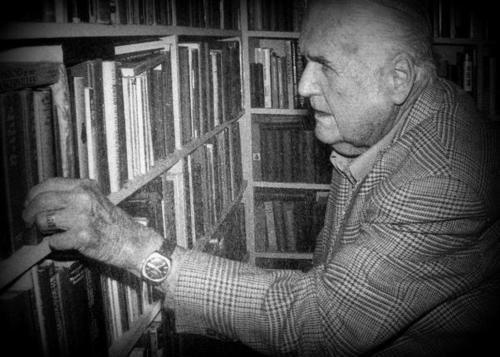
[John Bennett Shaw in his natural habitat, surrounded by books as far as the eye cab see. Personally, one of my only real Sherlockian regrets is that I personally never had the chance to meet JBS in person - instead I will happily settle for speaking to Sherlockians who had the good fortune of knowing him, corresponding with him and receiving a personal tour of his legendary Sherlockian collection at his home in Santa Fe prior to its move to University of Minnesota, Library Special Collections.]
It is an undisputed fact that JBS’s Sherlockian legacy is still clearly felt today, whether one looks at the enormous Sherlockian collection he bequeathed to the University of Minnesota upon his death or the ongoing tradition of Sherlock Holmes seminars, conferences and the like. One of the most digestible contributions left by JBS is the so-called ‘Shaw 100' or “The One Hundred Basic Books, Pamphlets and Periodicals relating to Sherlock Holmes" - a list maintained today by Timothy J Johnson, the E. W. McDiarmid Curator of the Sherlock Holmes Collections. Check out I Hear of Sherlock Episode 67: The Sherlock Holmes Collections with special guest Tim Johnson.
Black Gate, a SciFi/Fantasy site billed as “Adventures in Fantasy Literature”, has been syndicating a set of columns by Sherlockian/Solar Pons-ian Bob Byrne. Beginning in March, 2014, Mr Byrne has published at least thirty Holmes-centric posts all of which have been properly indexed under the title “The Public Life of Sherlock Holmes: An Index (So Far)" - plus some non-Holmes articles on Nero Wolfe and Dashiell Hammett. The Sherlockian essays tend to be written for a more general reader but are all worth perusing - though my only real concern is that Byrne promises/threatens to one day post a defence of the Matt Frewer movies”.
Bob Byrne also manages the excellent Solar Pons Gazette page “the only active newsletter dedicated to Solar Pons, the Sherlock Holmes of Praed Street.” When not hanging around Praed Street, Byrne releases a similar Holmesian newsletter entitled Baker Street Essays, the latest issue (#5) employing Vincent Starrett's “Evolution of a Profile” as a jumping off point to explore the classic decades of Holmes illustration, concluding on the enduring legacy of Paget and ending with BBC Sherlock's use of Paget motifs 110 years after Paget's original drawings.
 [Tom Richmond’s ‘The Game is Afoot Limited Edition Print’.]
[Tom Richmond’s ‘The Game is Afoot Limited Edition Print’.]
The above print by Tom Richmond depicts various actors portraying the Great Detective on screen over the years featured on Bob Byrne’s page. Click the image for information about ordering the above print by award winning MAD Magazine artist Tom Richmond.
I Hear of Sherlock Everywhere announced/reviewed two recent Sherlock-related DVD releases: the first is a Blu-ray DVD version of Granada’s Sherlock Holmes: The Complete Series and the second is the imminent release (November 4, 2014) of all nine BBC Sherlock episodes. Sadly, it sounds like Jeremy Brett’s series received nothing but a basic Blu-ray upgrade - same film-to-digital transfer, just presented in higher definition - adding zero content to the 2007 Granada DVD release.
Then there’s the opulent Sherlock Limited Edition Gift Set which packages all three seasons worth of BBC Sherlock episodes “on both Blu-ray and DVD, along with the original bonus features released with each season [and] all new commentaries, never-before-seen out-takes and exclusive collectibles including limited edition art cards and busts of Sherlock Holmes and John Watson.” If you need to buy a gift for a Sherlockian into mega-packaged DVD sets with tons of special features, then pre-order this ASAP. Personally I wonder if the included Holmes/Cumberbatch bust would pass the Moran/EMPT test, though I’ve always thought Monsieur Oscar Meunier, of Grenoble, received too much credit for his wax Holmes rendering opposed to Mrs Hudson’s dexterous manipulation of said rendering, which is what really tricked the Colonel into taking his final shot as a gun for hire, before being incapacitated by the recently reunited team of Holmes and Watson, and then led away in bracelets by Lestrade himself.
[One can only wonder how well the newest wax figure at London’s Madame Tussauds stacks up against Meunier’s Holmes wax bust from EMPT. And see this RadioTimes article “Benedict Cumberbatch wax figure in final stages" to judge for yourself.]
The Final Problem re-posted a set of high quality pages from one of the most famous Sherlock Holmes/Batman crossover issues in comic book history: Detective Comics #572 “The Doomsday Book” (March 1987), the cover of which features Sherlock Holmes, adorned in an Inverness cape, deerstalker and (of course, non-canonical) calabash pipe, sitting at a desk while Batman, standing behind him, points to some significant detail in a comic book which has both super detectives completely engrossed. Not a bad cover for the 50th anniversary issue of Detective Comics. “The Doomsday Book” was billed as “A mystery so strange…it takes the greatest detectives of all time to solve it!” The Comics Cube has a decent recap of what the issue is all about, though pertinent plot points involve Moriarty’s great-great-nephew, a flashback to an untold Sherlock Holmes case entitled “The Adventure of the Red Leech” - which is I assume a reference from GOLD when Watson reflects “As I turn over the pages, I see my notes upon the repulsive story of the red leech and the terrible death of Crosby, the banker.”
[One of my favourite Sherlock and Batman encounters with Batman offering Sherlock a light for his pipe and Homes replying that “Thank you, but I’m afraid the pipe is purely for show, these days.” Personally I like to believe that Sherlock is just putting on a show for ‘the kids’ and that he smokes his mix of pipes and cigarettes with the same relish as when solving the case of “The Man With the Twisted Lip" (1891). Image from Detective Comics #572: The Doomsday Book (March 1987).]
Footprints of London recently hosted “Literary Footprints” where Sue Bingham led the walk Embankment to Covent Garden – Literary Heroes. “Sue told some excellent Sherlock Holmes stories introducing us to Arthur Conan Doyle’s hybrid London of fictional and real locations. Within a few minutes she introduced the group to a building that was once a Turkish Bath mentioned in one of the stories. It was certainly not a building that you would notice unless you had it pointed out!.” I can only assume said Turkish Baths were referenced in “The Disappearance of Lady Francis Carfax” (where Holmes deduces that Watson has been to a Turkish Bath earlier in the day) though more likely she was referring to the start of “The Adventure of the Illustrious Client” where we find Holmes and Watson leisurely discussing a case Holmes had, until now, been reluctant to reveal to the ever curious Watson:
"Both Holmes and I had a weakness for the Turkish Bath. It was over a smoke in the pleasant lassitude of the drying-room that I have found him less reticent and more human than anywhere else. On the upper floor of the Northumberland Avenue establishment there is an isolated corner where two couches lie side by side, and it was on these that we lay upon September 3, 1902, the day when my narrative begins…"
If you’re planning a trip to London and interested in a literary-historical tout that appears to go significantly beyond the average tourist fare, make sure to check out their full schedule of walks and/or follow @SherlockWalks on Twitter.
The Sherlock Holmes Pub at 10-11 Northumberland Street [pictured above], Westminster, isn’t exactly an authentic canonical Sherlockian map point, but the international Holmesian jet-set crowd finds it to be an irresistible pit-stop for Sherlockians of all stripes - and the ‘The Study' does appear to contain a wax Sherlock Holmes post-Moran's air rifle and all among other Sherlockian goodies to inspect and pose for pictures.
Wheaton Public Library is celebrating Sherlock Holmes in all his many incarnations throughout October 2014 with special events, related contests, prize drawings, displays, and more! Unfortunately I’m just finding out about this program now, but there are still plenty of events scheduled including: “Footloose in England” (Thursday, October 16 at 7pm); “Radio Players: ‘The Speckled Band’ and ‘The Scandal in Bohemia’” (Sunday, October 19 at 2pm); The Hound of the Baskervilles - 1939 - Basil Rathbone (Wednesday, October 15 at 1pm); Sherlock Holmes: A Game of Shadows (Tuesday, October 21 at 1pm); a book discussion of The Hound of the Baskervilles (Monday, October 20 at 11am) Get updated info from Wheaton’s Facebook page. All events are located at 225 N. Cross St. Wheaton, IL 60187.
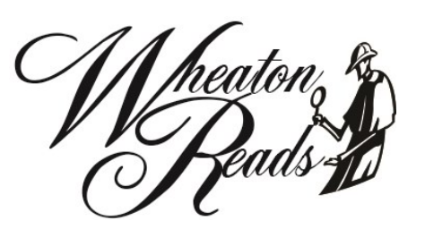
[There are still 12 days left in Wheaton Library’s Sherlock Fest.]
Leslie S. Klinger, fresh off the publication of his latest project the New Annotated H.P. Lovecraft, announced a huge batch of upcoming book signing events taking Klinger from coast to coast and everywhere in between. Mr Klinger was just in Chicago this last Saturday at the Sulzer Library where he read from and signed his New Annotated HPL. Make sure to check out Klinger’s page for a full list of upcoming speaking and signing dates from now until March 2015.
[Click the cover of Klinger’s New Annotated H. P. Lovecraft for his book signing tour dates from now until March 2015.]
The Daintiest (Bee) Under Your Bonnet Charity Ball 2015 will be held Thursday the 8th of January at 8:00 pm in the storied halls of the Player’s Club (16 Gramercy Park South, New York, 10003) as part of the Baker Street Irregulars Birthday Weekend. The theme this year is a Sussex Flapper Party and 100% of all proceeds from ticketing and the auction will once again benefit the Wounded Warrior Project. Admission is $45/ticket and covers buffet, goodie bags, live piano, a quiz & costume competition with prizes and the always exciting live auction. In order for the Charity Ball to succeed, we must implore again that you consider cleaning out your overstocked Sherlockian-oriented closets and bookshelves in order to supply treasures for the live and silent auctions. In the last two years your generosity has raised $8,000 for our war heroes - please bring some friends and join us once again for an evening of canonical fun and Mycroft-sized generosity.
[The Daintiest Thing Under A Bonnet Charity Ball - Proudly hosted by The Baker Street Babes. January 10, 2013. Photo by Melinda Caric (click for more photos.]
The Sherlockian Calendar continues to be maintained with loving care and devotion by Ron Fish - and is still the most useful and thorough listing of Sherlockian events available on the planet. I suggest consulting with the calendar prior to scheduling your event so as to avoid any unnecessary overlap. If you’re looking for an event in your area, this is the place to begin your quest.
* As I’m sure you’ve realized by now, the ‘Weekly Sherlock Links Compendium’ is back and, as always, I encourage anyone with interesting Sherlockian news, gossip, announcements or suggestions to please contact me at always1895[@]gmail.com *
** I’ll be catching up with a lot of Sherlockian news, links, podcasts, articles and essays published over the last 6 months, so please be patient with me and I’ll try to get as much material posted as possible in the next few weeks. **
March 4, 2014
Weekly Sherlock Links Compendium (February 15 - February 28, 2014)
Wondering what happened in the Sherlockian world during the second half of February 2014? Les Klinger discusses his interest in gothic horror literature, Steve Doyle talks about his life long pursuit of Sherlockian-centric publishing, the Baker Street Babes interview the minds behind UK Sherlock Con ‘Elementary’, a look at why someone wanted to exhume the body of Bertram Fletcher Robison, role playing on Baker Street, Paget illustrations recreated in Legos, what happens when you combine five different Holmes adaptations to create one seamless video, Moriarty overload, a whimsical look at the ‘rules’ for writing a Sherlock pastiche, Keefauver on the Sherlockian brave new world, a discussion of whether or not BBC Sherlock has diminished strong female characters in the Canon, is Steven Moffat an evil genius or just evil, upcoming Sherlockian gatherings of the Priory Scholars of NYC and the Three Garridebs of Westchester, a new play combining FINA, SCAN and STUD, a Sherlockian conference in the UK spends a day considering “His Last Vow”, an inside look at an event of the Amateur Mendicant Society of Detroit, and more in the latest Weekly Sherlock Links Compendium by Matt Laffey.
This post is dedicated to east coast Sherlockian scion personality and recently departed friend Joe Moran - you will be dearly missed sir.
[Click the above photo to read Francine Kitts’ I Hear of Sherlock's remembrance of Sherlockian Joe Moran. Photo taken at the 1991 ‘Back To Switzerland’ event sponsored by the Sherlock Holmes Society of London.]
Masters of Horror recently interviewed Sherlockian annotator extraordinaire Leslie S Klinger about: how he first became interested in Sherlock Holmes, Dracula and the scholarly side of gothic horror literature; his work as the official technical advisor for the Warner Bros Guy Ritchie Sherlock Homes films; his favorite horror literature and films, what it is like being a recognized world-renowned expert and award-winning author in the Sherlockian world, and more. My favorite part of the interview is when Klinger discusses his greatest accomplishments as a writer so far: ”I was deeply honored to receive the Edgar for my New Annotated Sherlock Holmes: The Complete Short Stories [Edgar Award for ‘Best Critical / Biographical Work’, 2005]. I always explain, however, that I stood on the shoulders of [William] Baring-Gould’s work. I had three great advantages over Baring-Gould: (1) The Internet and its amazing depth of Victorian works (in GoogleBooks and elsewhere); (2) the Ronald B. De Waal bibliography of all things Sherlock Holmes (over 25,000 entries), published after Baring-Gould’s death; and (3) I got to start with the work of Baring-Gould! I spent 37 years reading about Holmes, and it was an incredible opportunity to be allowed to distill that reading into 3,000 footnotes! I’m immensely proud of every one of my books. A great highlight of my writing career was the amazing opportunity to study the manuscript of Dracula, owned by Paul Allen and seen (by 2007) by only one other scholar, who wrote nothing about it.” Check out the entire interview for more insights into one of my favorite Sherlockians, Mr Leslie Klinger.
[Cover of Klinger’s New Annotated Sherlock Holmes, an essential tome for any Sherlockian library and serious fans of the mystery genre in general.]
Dan Andriacco interviewed Sherlockian publishing powerhouse Steve Doyle, BSI (“The Western Morning News”) about his life and work in the Sherlockian world which started at the tender age of 14 when he first received facsimiles of the Adventures and Memoirs to when he began publishing and editing his the legendary Sherlock Holmes Review (at 27 years old), a project that led him to Wessex Press/Gasogene Books and eventually becoming the publisher of the Baker Street Journal and author of the acclaimed Sherlock Holmes For Dummies. For a sense of just exactly how long Mr Doyle has been in the game, check out this fantastic video interview from 1987 featuring a fresh-faced, 27 year old Steven Doyle discussing the SHR, the current state (c. mid-1980s) of the Sherlockian world, the ever-growing network of Sherlockian scholars and like-minded fans from around the world and how no detective will ever rival the powers of Sherlock Holmes. My favorite part of Andriacco’s interview is the following: Andriacco: What is the best part of being a Sherlockian? Doyle: ”Being a Sherlockian gives you a key to a community of simply the best people I’ve been privileged to know. Literate, loyal, amazingly generous, absolutely delighting in the intellectual game of Sherlock Holmes. There’s absolutely nothing like it.” Here, here! Lastly, make sure to mark your calendars for Steve Doyle’s Wessex Press sponsored event From Gillette to Brett IV: Basil, Benedict and Beyond taking place in Bloomington, IN on September 12-14, 2014. The conference will feature rare Sherlockian films, vendors, and an all-star roster of distinguished speakers, presenters, and events, one major highlight being screenings of the 75th anniversary prints of Basil Rathbone’s The Hound of the Baskervilles (1939) and The Adventures of Sherlock Holmes (1939) at the state-of-the-art IU Cinema.
[Screenshot of Steve Doyle at 27 years old reading from an issue of his Sherlock Holmes Review during a 1987 interview.]
Baker Street Babes - Episode 53 finds Babes Kafers and Taylor making the trip to Birmingham, UK to attend a three day Sherlock Con (February 7 - 9, 2014) called ‘Elementary’ produced by Starfury Conventions (a professional UK convention organizer) whose main attraction was an appearance by the one and only Benedict Cumberbatch. Also on the bill were a number of other BBC Sherlock personalities including actor Lars Mikkelsen who played the late, lamented Charles Augustus Magnussen (“His Last Vow”), better known as Anderson (wonder if he had the beard?) and set-designer - all three of which appear on Episode 53. Find out what Mikkelsen and Aris think about the tremendous popularity of the show as well as how appearing on one of the most popular UK show’s in history has changed their lives. Jones opens up about life behind the BBC Sherlock camera and names some of his favorite sets he’s created. As a bonus, the Babes talk to a sampling of Sherlockian cosplay participants capturing the mood and spirit of the conference through the eyes of dedicated fans.
[“The clues and the evidence have all pointed in one direction, that the only solution for the growing army of fans for Sherlock is an unofficial event. Indeed, it’s elementary! A three day celebration, featuring guest talks, panel, discussions, and a fantastic opportunity for fans to gather around and share their enthusiasm for one of the best shows on TV today!”]
Western Morning News reported on the latest (and perhaps final) development in the controversial debate on whether or not ACD murdered author and journalist Bertram Fletcher Robinson (who died on January 21, 1907) by purposely administering a fatal overdose of laudanum (via Gladys, BFR’s wife), opposed to BFR’s official cause of death which was typhoid fever and peritonitis following a visit to Paris. For those unfamiliar with this controversy, ACD’s alleged motive for murdering BFR was two-fold: the first was an attempt to cover up an adulterous affair [ACD] had with his wife and the second was to hide the fact that [ACD] stole the plot of the Hound of the Baskervilles. “The accusations were the results of research carried out by former driving instructor Rodger Garrick-Steele who wanted to exhume the corpse…and test it for traces of poison….Having examined the evidence, Sir Andrew [McFarlane, the chancellor of the ecclesiastical court] said: “This court has been driven to the conclusion that it cannot place any reliance on as assertion made by RGS which is not backed up by an independent piece of evidence or source. On the basis of the material that he has placed before this court he appears to be a totally unreliable historian." BFR expert Paul Spiring exhaustively explains the details of the controversy in the well-written “Conan Doyle, Fletcher Robinson and the Hound" (BFRonline, 2009) - and for further background see "Did Conan Doyle poison his friend to cheat him out of The Hound of the Baskervilles?" (Telegraph, 2005). If you are unfamiliar with the work of Bertram Fletcher Robinson, I highly suggest checking out some of Paul Spiring’s books published by MX such as Aside Arthur Conan Doyle which features 20 illustrated short stories (1899-1907) by BFR. Spiring’s bibliography of BFR is available as a PDF online as are a number of BFR’s short stories which are in the public domain.
[ACD’s dedication to BFR in the published version of The Hound of the Baskervilles (1902). Spiring’s essay on BFR and HOUN describes earlier and later versions of this dedication plus a variety of references made by ACD in letters to BFR’s participation in the creation of HOUN, all of which make for fascinating reading, irregardless of the fantastic claims made by others regarding ACD and BFR.]
Baker Street: Roleplaying in the World of Sherlock Holmes is a Victorian-era RPG designed for 3 to 5 players where you become an investigator working out of 221B Baker Street solving cases as Dr. Watson during the conspicuous absence of Sherlock Holmes created by Bryce Whitacre for Fearlight Games. “Featuring over 30 careers, 25 unique criminal extras, and rules for making your own nefarious villains, Baker Street features a robust investigation mechanic, easy character generation, and rules for making your own mystery. Some of the unique features of Baker Street are The Sherlock Die, Investigation Scenes, Clue Cards, Social Status, and the Threat Meter.” To date this Kickstarter campaign has 451 backers who have pledged a whopping total of $22,860 (original goal was $3,500) - and there are still 12 days to go! If you’re interested, there’s still plenty of Kickstarter reward levels ranging from pledges of $1, $10, $15,….to major pledges of $100 (appear in the game’s artwork), $150 (receive limited edition hardcover version of rule book). Personally, I don’t know much about RPGs (think Dungeon & Dragons role playing games) but reading about Baker Street makes me want to find a few Sherlockians who are into RPGs. I’ll probably buy this game once it’s released regardless, if just to own the special Sherlockian die (multi-sided dice custom made for playing this game). For an in-depth look at Baker Street check out this dramatic video trailer.
[Rule book for Baker Street - for high level Kickstarter backers there is a special edition hardcover version bound in hunter green vellum with the official seal of the Conan Doyle estate embossed in gold foil on the front. Each book comes in a matching slipcover and will be hand-signed and numbered on the title page by the Baker Street designer, Bryce Whitacre.]
“A Scandal In Bohemia” Illustrated in Legos from MX Publishing is an attempt to capture the interest of younger readers by presenting the text of SCAN with all the traditional Sidney Paget illustrations re-created in Legos! Available soon from Amazon and other outlets, this paperback release is one of the more creative presentations of a Canonical text I have yet to see. Other MX titles geared towards the younger Sherlockians of the world include: Sherlock Holmes and the Missing Snowman (2012) where “a young girl’s snowman has gone missing. Where can it have gone? There is only one man who can help. Sherlock Holmes, the most famous detective in the world.”; two other MX titles of possible interest to a younger crowd include Is That My Holmes? (2013) and Is That My Watson? (2013) written by Andrew Murray and illustrated by Deakin Brook: “It’s so hard to choose, so spare a thought for poor Sherlock Holmes – faced with so many Watsons old and new, what will he do? Who’s too techno-garish? Who’s too teddy-bearish? Who’s maybe too pretty? Who’s in the wrong city? Who’s the right Watson in Holmes’s own view? And is Sherlock’s Watson the Watson for you?”
[A Lego-ized Irene Adler bidding goodnight to a bemused Holmes and Watson at the end of SCAN - click here for the original Paget illustration.]
The Sign of Four ‘mashup’ video, created by the talented Sherlockian from Iowa Monica Schmidt, is an extremely clever video that combines dialogue scenes from various Sherlock Holmes adaptations including Jeremy Brett/Granada Series (1984-1994), Ian Richardson’s The Sign of Four (1983), Charlton Heston’s The Crucifer of Blood (1991), Peter Cushing’s The Sign of Four (1968), Robert Downey Jr.’s Sherlock Holmes (2009), and Vasily Livanov’s “The Bloody Signature" (1979). Played in full, Ms Schmidt has managed to re-create most of the dialogue from Chapter 1 "The Science of Deduction" of The Sign of Four. Let’s hope Ms Schmidt has more video cleverness in store for us in the future.
Doyleockian makes the case for ‘less Moriarty and greater use of non-Moriarty Canonical villains’ when constructing new Holmes adaptations and pastiches. Instead of pitting Holmes against the, one again, resurrected (ad nauseum squared) Napoleon of Crime, Alistair Duncan suggests a laundry list drenched in Canonical depravity, avarice and skullduggery made up of villains such as “Baron Gruner, Culverton Smith, Isadora Klein, John Clay and/or Sir George Burnwell.” Missing from Duncan’s list - though equally capable in the scoundrel department in my opinion - are Josiah Amberley (RETI, gassed his wife and his chess opponent to death), Jack Ferguson (SUSS, assuming Master Jacky’s year at sea served only to refine his sociopathic tendencies), James Windibank/Hosmer Angel (IDEN, even Holmes predicted him destined for greater evils) and Parker the garrotter and Jew’s harp virtuoso (EMPT, because I’m pretty sure a garrotter is by definition a bad guy all around). As the above enumerations show, you will never find a more wretched hive of scum and villainy (to paraphrase from Obi Wan Kenobi’s description of the Mos Eisley Cantina) than in the Canon of Sherlock Holmes.
[“John Clay, the murderer, thief, smasher, and forger. He’s a young man, Mr. Merryweather, but he is at the head of his profession, and I would rather have my bracelets on him than on any criminal in London. He’s a remarkable man, is young John Clay…His brain is as cunning as his fingers, and though we meet signs of him at every turn, we never know where to find the man himself.” (REDH)]
Girl Meets Sherlock's Amy Thomas posted the whimsically titled “How To Write a Pastiche That Sparkle$!” which includes a number of very ‘helpful’ hints regarding how to compose a successful Holmes pastiche. In light of Duncan’s entry above, I think the most important point is tip #1 ”Include TONS of historical people. It’s called playing The Game. Who wants to read a pastiche where Holmes interacts in-depth with one historical person or situation? Subtlety is boring. Namecheck at least ten real-life characters, or you don’t deserve to call yourself a pastiche artist." I would go even further and suggest that the greater the number of historical and fictional figures included, the greater chance one has of achieving literary fame and fortune. Whenever I get around to writing my pastiche, it will include all three Moriarty brothers plus a fourth James Moriarty (but unrelated to the Professor, Colonel and Station Master) and a James Moriarty-bot built by none-other-than Holmes ‘other’ brother from that masterpiece of all Sherlockian cinema, Asylum’s Sherlock Holmes (2010). My only complaint about Ms Thomas’ list is that she forgot item #6 which goes something like ‘Make sure to establish that your pastiche is truly authentic by mentioning that said manuscript (in which the reader is holding at this very moment!) was discovered in your great-grandmother’s attic in a box marked “Grandma’s Les Liaisons Dangereuses: or Doctor’s I’ve Known and Loved” or similar locations.’
[Thorpe Holmes, the cybernetic-ized brother of Sherlock Holmes, in Asylum’s Sherlock Holmes (2010).]
Sherlock Peoria in “Standing Where You Might Get Finger Slipped” invites Sherlockians, perhaps dubious of the current Kickstarter campaign based around the notion of turning an obscure fan fiction piece into a web series, to pause for a moment and acknowledge the impressiveness of the A Finger Slip project: “We live in an age where a young dreamer can get an idea to adapt an idea based on an idea, with both of the last two ideas based on two other ideas, then raise $13,000 to fulfill that dream, funded by folks who want to see that dream come true…” Brad Keefauver then takes his argument one step further by suggesting that those critical of the project need to remove their blinders and realize that an important aspect of the brave new Sherlockian world is the multiplicity of perspectives now available to Holmes enthusiasts. Keefauver also successfully addresses a point I raised in last week’s post regarding Sherlock Peoria's ambiguity toward this brave new world: “I'm less and less sure of where I stand in our modern Sherlockian world for one simple reason: It's a much bigger place than it used to be and there are just so many, many places to stand now.” Lastly, a point which should be unequivocally un-ambiguous is Keefauver’s descriptive virtuosity as evidenced by the following turn of phrase: “And apparently, “A Finger Slip” has touched a lot of folks’s mental private parts." Indeed it has.
[An artist’s rendering of what the Sherlockian world of tomorrow will look like. If you look closely those are flying deerstalker cars.]
Sherlock Cares ran a reaction piece to the recent Daily Dot article “Sherlock Wrote a Female Character Out of a Classic Story, and Fans Aren’t Happy” essentially agreeing with the notion that Moffat’s adaptation “has modified the ending, and a critical moment, of an original Sherlock Holmes stories in which woman take decisive action and ultimately beat Sherlock Holmes in solving the problem.” In the case of Irene Adler, instead of “beating” Holmes as occurs in the Canon, she must ultimately be saved from a beheading. With Mary Morstan, instead of shooting CAM Devil, she instead turns to Sherlock to ‘save her’ from CAM’s blackmailing ways. The crux of both articles comes down to this: “In the original canon, there are many women whom even Sherlock Holmes admires for their strength of character, bravery, beauty, charm, and, yes, even their relative intelligence. But in BBC Sherlock it seems the women are there to serve “the boys.” And if the women are very, very lucky, “the boys” might rescue them and bestow a kiss…The moral in Sherlock is that women should not be smart, or if they are smart, they should not be ambitious for anything except love and marriage.” Is this evidence of Moffat and Gatiss’ inherent sexism? Does BBC Sherlock systematically morph independent female characters into helpless victims while simultaneously re-asserting the patriarchal status quo? After teasing out the facts (ie. the specific ways in which Moffat altered the Canon and portrayed various female characters) from the interpretation (ie. are Moffat’s alterations clear cut examples of sexism and/or a systematic strategy to put women ‘back in their place’?), do the claims of either essay hold up under close scrutiny or are there alternate, gender-neutral interpretations of either adaptation? Whatever your stance on these issues, the points raised are worth thinking about and discussing.
The Consulting Detective wonders whether or not Steven Moffat is actually an Evil Genius…or just a genius…or just evil. Actually, it only takes blog author Nick Cardillo half a paragraph to decide Moffat is “the world’s most formidable evil genius”, though later Cardillo defines ‘genius’ as knowing ”how to tell a good story” and ‘evil’ as “showmanship and flair”. Hmm, I was hoping for definitive proof that Moffat’s ideas on relationships were cribbed from an ancient book bound and written on human skin or that he drinks the blood of virgin fanboys for inspiration, but no such luck this time. This post does make a good point regarding the somewhat ambiguous role of Mark Gatiss at the BBC and in relation to Moffat. Is it the case that Mycroft is to the British Government what Mark Gatiss is to Sherlock? Perhaps Gatiss is the true, bonafide super evil puppet master pulling and manipulating the millions of delicate threads controlling so-called ‘feels’, that as of yet undiscovered component to the autonomic nervous system no doubt produced in the medulla oblongata and responsible for pretty much anything on Tumblr similar to the sentiment “I just finished re-watching “The Reichenbach Fall” and I had no idea I could feel so horrifyingly dead inside…. Anyone else?" with a #feels tag - oh wait, Sherlock Season 3 has come and gone and I guess Sherlock coming back wasn’t that big of a deal after all; certainly not as big of a deal as Sherlock shooting a dude in cold blood (but come on, he deserved it) and then sent off on a suicide mission only to be immediately recalled because of an animated GIF inexplicably appearing on everyone’s screens. Now that’s evil.
[Is Mark Gatiss the real evil genius behind BBC Sherlock?]
Sherlockian Event Links:
Priory Scholars of NYC will hold their next event on Saturday April 12, 2014 from 12:30 - 4:00 PM at The Churchill Tavern (45 East 28th Street, New York, NY 10016). Please confirm your enrollment via email to Headmistress Judith Freeman (judith-freeman@hotmail.com) no later than March 29, 2014. The discussion, led by Matt Laffey, will focus on “The Adventure of the Speckled Band.” Quizmaster Nick Martorelli will moderate a SPEC quiz, where the highest scoring attendees will receive a selection of prizes including books, Sherlockian artifacts, comics, etc. All Sherlockian enthusiasts are welcome, from the hardcore Prioryists to the curious newcomers. Make sure to follow us on Twitter and on Facebook for updated info and pre-game discussion. This event is dedicated to the memory of Joe Moran who, for a time, was the reigning headmaster of the Priory Scholars of NYC, circa 1994.
The Three Garridebs of Westchester will hold their next meeting at 1pm on March 22, 2014 at the Hastings-on-Hudson Public Library, NY. The discussion and quiz will be on “The Empty House” and attendees can expect the usual edifying lectures and always entertaining Sherlockian show-and-tell. Check out the 3Garridebs website for more information. On a related check, check out the latest edition of the Foolscap Document, the newsletter of the Three Garridebs.
Sherlock Holmes: The Final Adventure a theater production put together by the Chatham Players opens on March 7th and runs through March 22nd, 2014 at the Chatham Playhouse (23 North Passaic Ave, Chatham, NJ 07928). Tickets are $20 for adults and $18 for youth/senior. “Join Sherlock Holmes and Dr. Watson as they face off against arch-enemy, Professor Moriarty, in the Stephen Dietz story inspired by Sir Arthur Conan Doyle. The case takes Holmes on a final adventure, which includes kidnapping, numerous disguises, underhand plotting twists and turns and a whole series of clues which even has the super sleuth’s sidekick scratching his head…” According to the synopsis, the play combines elements of “The Final Problem,” “A Scandal in Bohemia,” and A Study in Scarlet with further inspiration drawn from William Gillette's Sherlock Holmes (1899). Available dates and times can be found here. (Thanks to Peter McIntyre and Bea Makara for the tip.)
New Directions in Sherlock is a free one day conference sponsored by Sherlock Holmes Past & Present happening on Friday, April 11, 2014 from 10:00 AM to 7:00 PM (BST) London, United Kingdom. “In this one-day symposium, we will screen “His Last Vow”, attend presentations, and discuss Sherlock Holmes, the BBC Sherlock, and aspects of neo-Victorian detective writing. The keynote speaker will be Dr Benjamin Poore of University of York.”
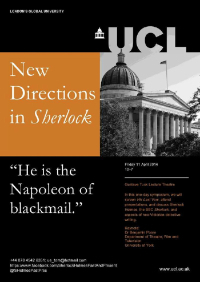
[Spend the day discussing all things BBC Sherlock, focusing primarily on “His Last Vow”.]
Amateur Mendicant Society of Detroit convened for their annual Winter luncheon - populated by 44 brave Sherlockian souls who braved a harsh Midwestern winter - on February 1, 2014 in Birmingham, Michigan. Tantalus of the AMS, Robert Musial, reports on the various goings on including toasts by Gloria Longueil saluting The Woman, Mike Smith toasting Watson’s Second Wife, Rob Musial raising a glass to Mrs. Hudson, Regina Stinson saluting Mycroft Holmes and Jerry Alvin commemorating the mysterious Ezekiah Hopkins; a silent auction where a bottle of one of the 221B Cellars wines (limited to 200 bottles total) went for $90; announcement of the winner of the highly coveted AMS Beggar’s Cup, commemorating the best presentation given at an AMS event in the previous year, which went to both Jerry Alvin and Regina Stinson who both shared in the glory due to a tie; Chris Jeryan's “A Holmesian Menagerie” exploring the Canon's alphabetical bestiary (“adder” and “bee,” winding through “jellyfish,” “kipper,” “leech” and others and on to “petrel,” “venomous lizard” and “whale”); the outcome of the All-Canon Quiz; and finally concluding the luncheon with Anne Musial and David Mohan leading the group in the standard singing of “God Save the Queen” and Lascar Jeryan with the traditional reading of Starrett’s poem 221B.
[Sherlock Holmes, 160 years young!]
February 13, 2014
Weekly Sherlock Links Compendium (January 25 - February 14, 2014)
While much of the East Coast and Midwest in the U.S.A. prepares to be buried under mounds of snow, I must confess that this latest post might bury even the bravest of Sherlockians under piles of Links and information. Below you will find an exploration of early Canonical illustrations, a celebration of the life and work of Vincent Starrett from IHOSE, a look at three Japanese translations of Starrett’s The Private Life of Sherlock Holmes, an interview with Steven Moffat and Sue Vertue on the future of Sherlock, Brad Keefauver explaining why we live in the most interesting of Sherlockian times, a review of the original 1979 Russian Sherlock for those only familiar with the latest Russian incarnation, an interview with Cumberbatch discussing his upcoming role as Alan Turing, Alistair Duncan on elements of the BBC Sherlock fandom, the Babes talking fanfic, a diverse list of 50 essential mystery novels, a list of Sherlock-related films available for streaming online, things to do on Long Island for the Sherlockian enthusiast, a cafe/shrine dedicated to Cumberbatch in Shanghai, Holmes & drugs, Holmes & muppets and much more in this fully winterized Weekly Sherlock Links Compendium by Matt Laffey.
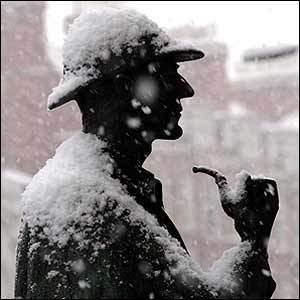
Baker Street Essays #5 (February 2014) the irregularly published PDF newsletter of Sherlockian Writings by Bob Byrne focuses on various aspects of illustrations from the Canon. The feature essay “The Illustrated Holmes,” inspired by the classic Walter Klinefelter book Sherlock Holmes in Portrait and Profile, traces the illustrations of Holmes (from the original STUD illustrations by DH Friston to those of Sydney Paget) that accompanied each story as it was first published. Also to be found in Issue #5 is the short essay “Thoughts on The Evolution of a Profile: Vincent Starrett’s Classic Essay” exploring the final chapter of Starrett’s seminal The Private Life of Sherlock Holmes (1939) entitled “The Evolution of a Profile”. In another essay “Sidney Paget’s Enduring Influence,” Byrne shows the enduring importance of Paget’s illustrations to historical and contemporary conceptions of the Great Detective by comparing original Paget illustrations with later adaptations - for example comparing Paget’s classic SILV train car depictions of Holmes and Watson with screenshots from Granada and BBC Sherlock adaptations which both pay homage to Paget’s original (cf. image below). Finally, “A Classic Scene” takes a close look at Paget’s famous depiction of Holmes and Professor Moriarty in the final moments of their struggle on the precipice of the Reichenbach, noting a small but significant feature of the drawing which I had never noticed: Paget “had every reason to believe that [FINA] would the last Holmes story, I think that Paget understood the weight of the moment and spelled out his name, instead of using the usual “SP”.” And indeed, if we look at said illustration we see that it is signed “Sydney Paget, 1893" opposed to the usual "SP". I highly recommend downloading BSE #5 (and it’s free!) and then exploring earlier PDF issues which can be found at Baker Street Essays.

[The Paget illustration from SILV (top) re-created by Granada (bottom) is just one example of Holmes adaptors (film, TV, etc) paying tribute to the immense importance of Paget’s imaginings of Canonical persons, places, scenes and outfits.]
I Hear of Sherlock Everywhere released episode 61 a few days ago and I couldn’t be more pleased! The announcement of a new IHOSE episode is always a cause for joy but in this particular case, the subject matter of this podcast is perhaps the nearest and dearest to my Sherlockian heart of any Sherlockian-related subject. I’m sure many of you have already surmised that episode 61 is all about that enigmatic but celebrated Chicago bookman, author of the finest book on matters Sherlockian aka The Private Life of Sherlock Holmes (1933) who was instrumental in the founding of the BSI yet only attended a single BSI Dinner (in 1934). “The Private Life of Vincent Starrett" is an hour and half conversation between venerable Starrettians Susan Rice and Ray Betzner about VS’s life, work, trials and tribulations, kept expertly on track by the gentle nudge of IHOSE hosts Scott Monty and Burt Wolder's keen sense of when expertise is being used to make a biographical or historical point versus expertise leading the expert (and listener) astray. I consider myself to be fairly well-versed in the life, times and work of Vincent Starrett but it felt like every two minutes or so I was hearing some hitherto unknown Starrettian fact coming out of Rice or Betzner’s brains. Personally, I learned a great deal but I was particularly impressed with the masterful way in which Rice and Betzner narrated their story, making the life of a cerebral book hound with quasi shut-in tendencies a thing of excitement and accessible to all levels of listeners. I know I always recommend finding a 90 minute chunk of time to treat yourself to the latest IHOSE podcast, but there’s no doubt in my mind that old and new Sherlockians alike will want to focus completely on this show - so do yourself a huge favor, find a quiet corner where no person can vex you and lose yourself in contemplation of “only those things the heart believes are true.”
[Starrettian soldiers Susan Rice and Ray Betzner, along with a copy of Rice’s The Somnambulist and the Detective (2000, Musgrave Monograph Number 10 ), recording their IHOSE segment during BSI Weekend 2014 at the Player’s Club in Gramercy Park, NYC.]
Studies in Starrett (as if a 90 minute podcast dedicated to the man wasn’t enough), the blog of longtime Sherlockian and Starrettian Ray Betzner, details his quest to obtain Japanese translations of VS’s seminal The Private Life of Sherlock Holmes. Even though I don’t read Japanese, this is the sort of quest that gets a red-blooded American blogger like myself all hot and bothered. But I’ll take a quick cold shower and let Betzner explain where his quest started…
“The Private Life of Sherlock Holmes in Japan Part 1”: “I was able to determine that there had also been two Japanese editions. Both were translations by Tsukasa Kobayashi and Akane Higashiyama, who have translated a number of Sherlockian classics for Japanese readers. A hardback edition of Private Life was published in 1987, while a paperback version came out in 1992.” Not surprisingly, given enough time and patience - and the Internet and some collector friends - both editions were tracked down and dutifully added to Betzner’s impressive VS library. Not long after Betzner secured his hardback and paperback editions, he accidentally came across a folded-up, one sheet advertisement for the 1992 paperback edition which revealed that “before the first Japanese edition was published, chapters of Private Life translated by Kobayashi and Higashiyama were serialized in the Japanese edition of Ellery Queen’s Mystery Magazine….so the hunt goes on!”
“The Private Life of Sherlock Holmes in Japan Part 2" Betzner shows off the fruits of his labor and explains the differences between both Japanese editions plus some further information about the earlier EQMM Japan translation, stressing one important caveat: “I am tempted to say this is the complete history of Private Life in Japanese, but I’ve been burned too many times in the past to be confident of such a claim. Just when I think I know something definitive about Vincent Starrett, some new tidbit comes to light and I realize I’m still several puzzle pieces short of the full picture.”
[Above you’ll see the cover of the 1992 paperback edition of The Private Life of Sherlock Holmes in Japanese, which is a translation of the original 1933 edition opposed to the hardback Japanese translation which is based on the 1975 Pinnacle Books paperback edition (similar to the 1960 updated version originally published by University of Chicago Press).]
Collider sat down with Steven Moffat and Sue Vertue for an in depth discussion on what’s next for BBC Sherlock, when fans can (maybe) expect Seasons 4 and 5 and the advantages of not being bound to a standard TV season/series model. Even if you’re not a fan of BBC Sherlock, Moffat’s comments on challenging the television season format status quo is a tremendous breath of fresh air: “If we made Sherlock the ordinary way, and did a run of 6 or 12, it would have been over by now…Who says that the only way to make television is to make loads and loads of episodes for five years, until everybody is absolutely sick of it, particularly the people who are making it. Who says that’s the only way you can do it? There are other ways to make television. I’ve heard so many American showrunners talk about the shorter run – which for them is 12 or 13, but that’s quite a long run for us – and that all you’re losing are the filler episodes, and I think that’s true. I do think that sharpening the appetite and having shorter runs of more shows is a better way.” Hallelujah! Next time you find yourself complaining about the perceived dearth of BBC Sherlock episodes, consider the ‘less is more’ philosophy advocated by Moffat.
[Steven Moffat and Sue Vertue, ostensibly pleasant and good-natured people, are secretly (and delightfully) plotting the emotional destruction of their legions of fans - or so listening to the perennial lamenting of a portion of the Sherlock fandom might lead you to believe. The truth? Let’s just assume it’s somewhere in the middle.]
Sherlock Peoria muses on the current state of the Sherlockian world, comparing the effect which recent Sherlock-mania has had on the traditional Holmes world to that of a small, quiet village suddenly finding itself in the midst a giant modern housing development replete with big box chain stores and all the traffic and congestion which inevitably follows. An odd metaphor to choose, yet the point is clear: the Sherlockian world of 2014 is radically different than the Sherlockian world of just a decade before (and there’s no ‘going back’). Regardless of your personal stance on said changes most observers would agree with Brad Keefauver when he adds that “watching the Sherlock boom’s effect on the old school Sherlockian world has been interesting.” For long time readers of Mr Keefauver’s blog, it’s sometimes unclear where exactly he stands regarding the brave new Holmesian world we find growing around us every day. Note: I don’t claim to be an expert in Keefauverian Studies, but just an attentive Sherlock Peoria reader (P.S. Please bring back Action Sherlock Brain Theater!)
I sense that Keefauver’s personal view is a nuanced, pragmatic conception which goes beyond a simple reactionary, binary world view (ie. not ‘totally good’ and not ‘totally bad’), though perhaps he’s leaning a bit more to the positive than the negative, which would explain Keefauver’s explanation: “But man, is this a cool time to be a Sherlockian," a sentiment shared by many a Sherlockian on either side of the great continuum. After finishing the essay, a single deafening quote frantically ran circles around my brain: I of course refer to that famous Chinese curse: "May you live in interesting times…" In order to get said quote out of my head, I looked up the actual origin of the phrase (surprise, it’s not really an ancient Chinese proverb at all) and the only actual ancient Chinese proverb it even remotely resembles goes something like this: "It’s better to be a dog in a peaceful time than be a man in a chaotic period." Strangely comforted, I held myself back from mentioning the dog that did nothing in peaceful times and instead found the following image to accompany this entry:
[For a fascinating perspective on Sherlockian ‘boom’ times, check out back issues of Baker Street Miscellanea from the late 1970s (or order the entire run on disc from Battered Silicon Dispatch Box) when the Sherlockian world was then dealing with an enormous upsurge in Holmesian interest generated by the recent book and film versions of The Seven-Per-Cent Solution as well as a smattering of other new Sherlock pastiches. As you can probably guess some welcomed the newcomers and praised the new conduits that sparked the interest of new recruits - and others were up-in-arms over the dawning apocalypse being visited upon their Sherlockian world.]
The Consulting Detective describes the author’s recent first encounter with the original Russian Sherlock Holmes (1979 - 1986) - featuring Vasily Livanov as Sherlock Holmes and Vitaly Solomin as Dr Watson: “overall its en excellent representation of the Arthur Conan Doyle canon. Despite the fact that Vasily Livanov’s Holmes is played somewhat against type, he lends an excellent performance as a humane Holmes. The friendship between Holmes and Watson is excellently characterized, defined with good humor and rapport.” Every time I read a new review of the original Russian Sherlock Holmes series I immediately want to drop whatever it is I’m working on (ie. usually another round of Weekly Links), turn on the series somewhere near the early-middle (perhaps the scene where you’re never really sure whether you’re watching Moriarty and Moran or the Wolfman and his monster associates) and thoroughly enjoy what I often times feel is the second best Holmes adaptation of all time (Granada/Brett taking first place). I’m often shocked when Sherlockian friends - often times with decades more experience behind them - casually mention they have never seen Livanov and Solomin as the Dynamic Duo of Victorian crime fighting. Seriously, if you haven’t seen this series yet, make the time!
[Hey, remember when Sherlock Holmes was not just a chemist but a profound chemist? Unlike pretty much every Holmes adaptation ever (excluding Granada), the classic Russian Holmes series never lets you forget that Holmes is a chemist of no small talent, just like it should be.]
USA Today ran a mostly puffy puff interview piece with Benedict Cumberbatch discussing the possible casting of BC in JJ Abraham’s bizzaro-world take on Star Wars and whether or not BC has a paramour or is completely single and enjoying being the most popular man on the planet. Wading through the fluff, BC does speak-up about his upcoming roll as Alan Turing, mathematician, WWII code breaking hero and, at the end of his life, shamefully and completely disgraced by the UK Justice system (which still prosecuted accusations of Sodomy): “[Cumberbatch] expresses displeasure only when an interviewer mentions that the late Turing received a royal pardon recently for 1950s criminal charges of gross indecency related to homosexuality. “The only person that should be pardoning anybody is him. Hopefully, the film will bring to the fore what an extraordinary human being he was and how appalling (his treatment by the government was). It’s a really shameful, disgraceful part of our history,” [Cumberbatch] says of his The Imitation Game character.” Without the genius of Allan Turing, computers might not exist or not exist at the level in which they do today as well as a variety of other artificial intelligence and information theory concepts. I can only hope that BC’s fame will help bring greater awareness to Turing’s story.
[Sherlock Holmes, Smaug, Julian Assange, Khan from Star Trek, Stephen Hawking (seriously, in a made for TV movie called Hawking) and now Allan Turing - is there anyone famous who doesn’t happen to look like Benedict Cumberbatch?]
Doyleockian gently suggests that certain extreme wings of the so-called fandom “need to get a grip” further explaining “I don’t pretend to know an awful lot about the activities of fandom – and by this I am referring to the social media savvy fans whose Sherlockian interest largely revolves around BBC Sherlock – but as a body it can be awfully touchy and has a tendency to the very intolerance it seems to identify and abhor in others.” Strong words of course, but well thought-out and sincere words all the same - for those familiar with Alistair Duncan and/or his Sherlock-centric writings it should come as no surprise to see Duncan not only develop his own, independent views on the topic at hand (in this case, the collective behavior of at least part of the Sherlock fandom) but also prepare in advance a defense should the need arise.
Frankly, I’m rather surprised his post, originally published 30 January, 2014 under the clearly provocative title: “Some elements of fandom need to get a grip”, only generated 10 or so direct Comments. Secretly I thought that Duncan’s short post might possess the perfect mix of l’attitude provocative and measured objectivity triggering a larger dialogue (disguised at first perhaps as an argument) between various fandom culture supporters and detractors leading to….leading to where and to what I don’t know. Regardless, there are points to Duncan’s original post that many ‘observers’ (all those Sherlockians unconcerned with battling out the finer semantics of “fandom” regularly in the social media trenches) as well as self-identified fandom denizens would be interested in seeing addressed and discussed - though not confronted savagely or uncivilly leading to predictably unproductive ‘flame wars’ and the like. I’ll continue to look out for the next big argument brewing, not for voyeuristic or sadistic purposes but because these sorts of continually simmering, though never boiling, disputes tend to have a way of staying below the radar until the moment that they don’t just boil over but explode in all the passion and madness inherent in the creative minds of the types of people who choose to socialize within the framework of a literary or quasi-literary social group opposed to something more traditional.
[No doubt Boromir has a firm grip on whatever the current controversy might be.]
Baker Street Babes in podcast episode # 52, spoke to the team behind ‘A Finger Slip: The Webseries’ a project meant to take a specific popular fan fiction and turn it into a video series, funded in part by a current Kickstarter campaign….Already I hear a few Sherlockian heads exploding out there - and giving vent to some fine and violent oaths - but let’s step back for a moment and tease out a few points just so that we’re all on the same page (or have the ability to be on the same page). The fanfic is called “A Finger Slip” (AFS) and was originally authored by Pawtal (put simply) and is based on the premise that “John and Sherlock accidentally meet through texts as teenagers”. Got it so far? From what I’ve seen the entire Finger Slip adventures are told in the form of text messages between our two protagonists along with other BBC characters like Greg (Lestrade) and Molly (Hooper). It’s all online and free and you can start here with “Chapter 1”, where you’ll find young, college-aged John and Sherlock meeting and getting to know each other via text messages. Remember, this is fanfic and not burlesque or pastiche so as much as the two main characters are John Watson and Sherlock Holmes, don’t be surprised if the narrative particulars and personalities stray quite far from what you would expect from a fan created (for example) ‘BBC Sherlock-inspired pastiche’ story. Anyway, if you had no idea what anything in the first few sentences of this entry meant, now you at least have a vague idea of what’s happening. Give Episode #52 a listen then if you’re curious come back and check out the Kickstarter page (for more info about the page to screen transformation) and the series website afingerslipofficial.tumblr.com and Twitter @AFSwebseries.
[If fanfic stuff isn’t your cup of tea, I’m right there with you, generally speaking, but the AFS project appears to be popular enough that a basic working knowledge of how Sherlock fanfic culture works could be useful to a better understanding of the fanfic corner of the greater Sherlockian world.]
Flavorwire in “50 Essential Mystery Novels That Everyone Should Read” put together an eclectically comprehensive list of fifty novels which all fall under the rubric of ‘Mystery Novels’ to one degree or another (crime, spy, detective, etc.). For starters, three cheers to Flavorwire author Emily Temple for actually putting thought into a “Top 50 Best X’s” list - it contains plenty of titles/authors you would exactly expect to find on a ‘best of’ list like Dashiell Hammett or Raymond Chandler. But hardboiled detectives are not sui generis aberrations of Nature lacking parents and lineage: hence a healthy sampling of ‘classic mystery’ including the likes of Poe, Sayers, Wilkie Collins and Watson’s Literary Agent. Then the choices get a bit more interesting, diverse and dare I say literary: Umberto Eco’s The Name of the Rose (OK, this is an obvious and overly popular choice but just once I would love to see Foucault’s Pendulum appear instead), Paul Auster’s The New York Trilogy and one of my favorite novels from the last decade The Yiddish Policemen’s Union by Michael Chabon. Perhaps the most interesting and impressive selections is by a scrappy, young, living, female author whose Dust and Shadow transcends the sub-sub-sub-genre of Sherlock Holmes pastiche: I refer to one of Always1895.net’s favorite contemporary Sherlockians and authors, Lyndsay Faye! (Thanks to Les Klinger for the tip!) Irish America posted a recent interview with Lyndsay Faye about her latest novel Seven For a Secret as well as future projects.
[Don’t get me wrong, I think Poe can sometimes be a genius and there’s no question his Dupin stories inspired a genre that lives on after 150+ years but seriously, check out this cover: do they really need to scream “The First Detective Auguste Dupin!!” in giant letters to convince readers to buy a set of Dupin stories, two of which are probably the most famous mystery/detective stories ever: “The Murders in the Rue Morgue” and “The Purloined Letter”?]
Vulture compiled a list of Sherlock Holmes film and TV adaptations currently available from various online streaming services such as YouTube, Amazon, Hulu, Netflix, etc. The Woman in Green, Murder By Decree, my personal favorite Billy Wilder’s The Private Life of Sherlock Holmes, Buster Keaton’s silent classic (though not an adaptation per se) Sherlock, Jr., all 39 episodes of the 1954 Ronald Howard TV series, Arthur Wontner as Holmes in what is possibly the most confusingly titled adaptation of all time Murder at the Baskervilles (set in the environs of the Baskerville estate, the plot is roughly based on “Silver Blaze” with Moriarty thrown in to properly ruin Holmes’ vacation plans) and many more. Not mentioned in the article is the great repository of free, classic films Archive.org which has most of the public domain Sherlock adaptations available for streaming/downloading.
[Movie poster for Wontner in The Triumph of Sherlock Holmes (1935), which can be downloaded directly at Archive.org.]
Explore Long Island ran a piece titled “Spy Like Sherlock Holmes on LI” making a myriad of excellent suggestions for the aspiring Sherlockian: Warren Randall’s The Long Island Cave Dwellers scion meetings, Long Island’s Murder Mystery Players club, the Spy Shop of Long Island in Northport, the comic shop Collector’s Kingdom with a selection of Holmesian titles, and more. Extra props for a reference to founder of the BSI and longtime Roslyn, LI resident Christopher Morley as well as his writing studio, the Knothole, which lives at Christopher Morley County Park in Roslyn-North Hills. The article says the Knothole is currently closed to visits by the public, but I can’t find any more news on that - possibly it’s just closed in the Winter?
UPDATE: Former Supervisor of Historic Sites for the Nassau County Dept. of Parks, Recreation and Museums, Terry Hunt, BSI (“The Something Hunt”) after reading this entry wrote me the following regarding the state of Morley’s Knothole: “The Knothole has been closed to the public since the BSI’s Morley Pilgrimage in Jan. 2009. We used to open it seasonally; in the spring we’d furnish it as shown in your picture, and in the fall remove most of the furnishings from the unheated building and put them in storage…The big problem is that the County is broke and the museum division essentially no longer exists. I have hopes that we can get The Knothole re-opened for some time next year for Morley’s 125th birthday year, if the Christopher Morley Knothole Assn. and other Morley supporters can show enough interest and volunteer support.” Thanks for the info and congratulations on your recent investiture Terry Hunt! Let’s hope with enough support Morley’s Knothole will one day be open to the public again.

[The interior of the Knothole, the writing studio used by Christopher Morley - which was moved to the Christopher Morley Park after Morley’s death.]
Buzzfeed ran a story about a Sherlock-themed coffee shop in Shanghai, China called 221B Baker Street. It’s worth perusing the pictures but I tend to agree with the author that the cafe is less about Sherlock Holmes and more about being a literal shrine to Benedict Cumberbatch in the guise of Sherlock. I’ve been making a point of not getting swept up in the recent torrent of Western News articles - ie. “Wow! Check out how ‘totally wacky’ China is over BBC Sherlock (cf. Curly Fu and Peanut), etc..” - but since this cafe is so over-the-top I’ll make this one time exception.
[The daily menu board for China’s shrine…I mean cafe dedicated to Benedict Cumberbatch and to a less extent other actors who’ve donned the deerstalker of the Great Detective.]
A random Ebay auction is where I found this rather odd and harrowing image of the Great Detective smoking a suspiciously non-Canonical looking pipe on what appears to be the mean streets of the Marylebone district of the City of Westminster in London where one can only hope Holmes is lecturing the ‘street arabs’ of drag-ravaged Baker Street that “Crack is Wack” (or words to that effect). According to the description, this is an anti-drug comic from 1979 put out by a company called Stash Comix titled “Who Took the Drugs” and features Holmes in at least one story about the perils and pitfalls of drug use. For posterity’s’ sake, I grabbed the cover image off the eBay auction so that one can still marvel at the infinite variety of situations artists have placed the likeness of Sherlock Holmes. It is of course understandable if you assumed this image was an outtake from BBC’s “His Last Vow”, particularly in light of the recently revealed lifestyle choices of one ‘Bill Wiggins’ within the BBCverse.
[My money is on Mrs Hudson in answer to “Who Took the Drugs?” Click this rather disturbing but also highly entertaining image for the full-sized version. Extra blog points if anyone has ever read this comic and can email me a recap the Holmes story contained within.]
The Washington Post, to offset the bleak 1970s version of Holmes seen above, did a thorough job of covering Benedict Cumberbatch’s recent appearance alongside Murray the Monster and Count von Count as they attempt to teach kids the concept of ‘greater than’ in relation to numbers. Warning: will melt even the most ice-hardened hearts of anti-Cumberbunny Sherlockians. Watch the entire two and a half minute segment here: Benedict Cumberbatch and the Sign of Four (or is it Three?).
[The boys from Sesame Street call in the man from Baker Street to help solve the seemingly intractable mystery of whether or not there are more apples or more oranges.]
January 24, 2014
Weekly Sherlock Links Compendium (January 11 - January 24, 2014)
BSI Weekend 2014 has come and gone and though I have enough personal reminiscences and links to fill multiple posts, I’ve been given the tremendous honor of writing the review of BSI Weekend for the Spring 2014 issue of the Baker Street Journal - and if you don’t already, subscribe to the BSJ immediately!
To tide you over until then, here’s a wealth of Sherlockian news from the last two weeks including: a new website dedicated to Vincent Starrett, I Hear of Sherlock Everywhere celebrates their 60th episode with an engrossing overview of the first sixty years of Sherlockiana, a Sherlock-themed video segment on Mo Rocca’s Sunday Morning on CBS, a transportation expert criticizes Sherlock’s inability to identify trains, the new Russian Sherlock adaptation has been subtitled in English, a roundup of articles on China’s obsession with Curly Fu and Peanut, Sherlock Holmes as the ultimate superhero, a familiar face appears on the cover of Entertainment Weekly, join the Homeless Network on your smartphone, Charlotte Anne Walters published a new pastiche collection of short stories, an argument for why Nicol Williamson’s Holmes is the best Homes ever, who is Michael Stone and why would his conviction “cause the author of the Sherlock Holmes stories to choke on his pipe” and more in this information-packed, post-BSI Weekend, Weekly Sherlock Links Compendium by Matt Laffey.
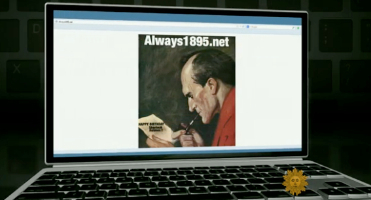
Studies in Starrett, as regular readers can well imagine, is quickly on its way to becoming my new favorite blog. Maintained by Ray Betzner, the editor of Gasogene Books’ 75th Anniversary Edition of The Private Life of Sherlock Holmes, I have no doubt that VincentStarrett.com will soon be the go to source for all things related to Autolycus of Chicago. To date, the site features articles on: Starrett’s connection to Poe’s almost mythical book Tamerlane, a Chicago Tribune Sunday Magazine article from 1969 celebrating VS’s 82nd birthday, an analysis of Michael Kean's recent Baker Street Journal (Winter 2013) article “”And It Is Always…” Eighteen Eighty-nine”, a little known VS short story “The Menace of Mars” (1922) co-authored with Otto McFeely and the Starrett connection to Betzner’s inscribed copy of The Last Egyptian by Wizard of Oz author L. Frank Baum. When not researching the life and work of Starrett, Ray Betzner writes about campus news at Temple University in Philadelphia where he is the Assistant Vice President of University Communications. In the Sherlockian world, Betzner has been an invested member of the Baker Street Irregulars (“The Agony Column”) since 1987, maintains “The Sherlockian Societies” section of the Baker Street Journal and has published numerous articles in Sherlockian journals such as the BSJ, Baker Street Miscellanea, etc. Most recently Betzner was quoted in The Guardian waxing philosophical about what it means to be a Sherlockian and why critics should lighten up regarding BBC Sherlock. You can follow Betzner on Twitter via @BooksandBipeds.
[Ray Betzner, proprietor of Studies In Sherlock, toasting Dr John Watson by noting Watson’s transformation from The War Doctor to the doctor we know and love at the Baker Street Babes’ Second Annual Daintiest Thing Under a Bonnet Charity Ball during BSI Weekend 2014.]
I Hear of Sherlock Everywhere celebrated their 60th podcast episode by surveying the first sixty years of Holmes’ existence, starting in 1887 with the publication of A Study in Scarlet and pausing in 1947, one year after the founding of the Baker Street Journal. Scott and Burt do an excellent job charting and contextualizing the rise of a new kind of popular literature - serialized fiction in nascent publications like The Strand - and the unlikely success of a new kind of detective. Though the story of ACD’s love/hate relationship with Sherlock Holmes is familiar to some, newcomers to the Sherlockian world will be shocked at how inconsequential Holmes was to the young Edinburgh doctor-turned-author and how frighteningly close the world came to losing the Great Detective forever in 1891 to the falls of Reichenbach. The onset of the 20th century not only saw Holmes rise from the dead but also saw the rise of Sherlockian scholarship. Three decades later ACD, never quite having made peace with Holmes, would be dead and buried (with a tombstone that read “Steel True, Blade Straight”), while his problem child (and I don’t mean Denis or Adrian) achieved immortality in the form of small gatherings dedicated to the study and propagation of the sixty stories documenting the friendship and adventures of Sherlock Holmes and Dr Watson. By the 1940s these informal groups had evolved into full blown societies replete with formal dinners, journals, traditions and the inevitable growing pains experienced by the maturation of an ever growing subculture. You couldn’t ask for more knowledgeable or affable guides to the intertwined worlds of Sherlock Holmes in print and the people and culture that celebrate the Great Detective’s adventures.
[In the beginning there was…A Study in Scarlet published in 1887.]
CBS Sunday Morning aired “Deducing the Timeless Popularity of Sherlock Holmes” on January 19, 2014 which also just happened to coincide with the final day of BSI Weekend 2014 in NYC. What better treat could a Sherlockian ask for - regardless of whether or not they attended the NYC Sherlock festivities - than to watch a Holmes-centric news segment that essentially ‘got it right’. Watch the joy (though some might call it insanity) in the face of Don Hobbs explaining the pleasure of collecting translations of the Canon in 92 languages: “”What doesn’t he have? Tajikistan? He’s got it. Uzbekistan? “I do,” [Hobbs] replied.”“ Listen to Michael Dirda, author of On Conan Doyle, describing the historical and literary significance of Holmes as the first serialized character. Enjoy the pageantry of the 221B Con 2013 costume contest where you’ll find outfits that could only emerge from the brains of devoted Sherlockians. Let loose a little Elementary snark as Jonny Lee Miller talks about his tattoos and fails to comprehend why someone might collect the Canon in a billion languages, while Lucy Lui reassures viewers that she won’t be undergoing sex reassignment surgery to placate those critical of the casting of a female Watson. Finally, once the segment is over, sit back and ponder the multi-faceted world of The Sherlockian in all its glory: the strange and sometimes counter-intuitive diversity, “the unrestrained enjoyment of the present” (MAZI) and the rigorous dedication to a timeless friendship between an anti-social genius and a gregarious doctor with romantic tendencies - then give thanks to the personal confluence of events which led you to Baker Street.
[Above, Don Hobbs discusses what drives a man to collect 92 translations of the Canon. Towards the end of the piece Always1895 and a few of my other favorite Sherlockian sites are mentioned: “[Sherlock] fans met in cyberspace, on sites like the Baker Street Babes, Always1895.net, Better Holmes and Gardens.” While I don’t think any fans actually ‘met’ on my site, I certainly do appreciate CBS mentioning it and if I had a hit counter I’m sure it would be at 1,895,000 by now.]
Stephen Rees’s Blog, concerned primarily with transportation in urban environments, recently commented on a seemingly minor detail from the season three premiere of BBC Sherlock. While many fans and critics took issue with plot holes such as how exactly the villain managed to detach an entire train car and reroute it to the abandoned station or un/under-explained situations like how exactly Sherlock survived the St Barts fall, Mr Rees was “severely disappointed” by Holmes’ inability to distinguish between two types of London trains: “Throughout [“The Empty Hearse”] the abilities of the great detective are demonstrated. He can, for instance, conduct a forensic examination of human hair inside a toque without even a magnifying glass. But he cannot apparently tell the difference between a tube train on the Jubilee Line and the subsurface stock on the District Line.” (Thanks to John Baesch, BSI (“State and Merton County Railroad”) for the tip!)
[Example of the Jubilee Line tube train - which you can compare to the District Line train for yourself.]
The Millions contrasts the current hullaballoo surrounding the recent premiere of BBC Sherlock with various historical high points in the Sherlockian world : “Holmes booms have come and gone over the decades - the last major influx of adaptations was in the seventies - and though most are set amongst the old ‘swirling-fog-and-hansom-cabs’, they manage to tap into the anxieties of the ages in which they were conceived.” Below is a graph of instances of “Sherlock Holmes” mentioned per year (1887 - 2008) within a corpus of 5 million digitized books which paints a rough picture of the high and low points of Holmes’ popularity over the last 120 years.
[Ngram view of “Sherlock Holmes” mentions from 1887 to 2008 in Google’s book corpus. Click the image to interact with the Viewer or here for a larger version of the above image. For those unfamiliar with Google Ngram Viewer, it’s a “phrase-usage graphing [which] charts the yearly count of selected n-grams (letter combinations)[n] or words and phrases, as found in over 5.2 million books digitized by Google Inc (up to 2008)”]
Russian Sherlock Holmes (2013), the newest Holmes incarnation to hit the small screen, can now be viewed with English subtitles! At the time of this post Russian Sherlock Holmes episode 1x01 is available on YouTube with subtitles that can be toggled on or off. For more information about the series, I Hear of Sherlock Everywhere posted an overview of the first few episodes. And the Baker Street Babes reviewed a few individual episodes, having exclusive access to a Russian speaking roommate (whom I assume also helped “solve the problem as to whether it is possible to get comfortable rooms at a reasonable price”).
BBC News China reports on the latest ‘craze’ to sweep China’s TV watching public: “”I tore myself away from bed early this morning just to watch 90 minutes of my Curly Fu and Peanut,” said one online comment. “The gay-citement has finally returned. PS: Thank you, Prime Minister Cameron, for visiting China.” "Curly Fu" and "Peanut" are the names given by Chinese fans to Sherlock and his sidekick, Dr Watson, because they resemble the Chinese pronunciation of their names. The “gay-citement” tag? Well, that is used to describe the excitement of seeing what Chinese fans like to think of as the love between the two characters.” The Internet seems fascinated with the, in truth rather endearing, Curly Fu and Peanut monikers and the ‘strange’ Chinese obsession with BBC Sherlock (cf. Anglophenia, Metro, Mail Online, etc.).
[A typical headline proclaiming the Chinese fascination with Curly Fu and Peanut’s (Sherlock and John respectively) bromance.]
Scientific American in “Why You Should Envy, But Not Worship Sherlock Holmes” makes an extremely interesting case for why Holmes should be considered the ultimate superhero: “Despite the flaws, we want to think like Sherlock Holmes, we want to be a superhero of the mind. Why? Why has Holmes endured for so long in the public’s own thinking? Why can everyone, not just the nerdy, embrace the movies and TV shows that feature the detective? I think it’s because Sherlock Holmes is the most realistic superhero of them all.”
[Screenshot from BBC Sherlock - and here is the obligatory t-shirt version at Qwertee, which I kind of think looks pretty cool.]
Entertainment Weekly, in the January 24, 2014 issue, features the very familiar face of Benedict Cumberbatch on it’s cover along with the tagline: “How the British cult hit starring Benedict Cumberbatch became the whole world’s cup of tea.” The article begins with a surprising revelation on what could have been: “Cumberbatch thought twice when Sherlock co-creators Steven Moffat and Mark Gatiss originally offered him the part….Why? “My reservation was ‘Well, this is a very iconic character, there will be a lot of attention on it,’” says Cumberbatch. “This was before I had had any significant success [but] I knew there would still be a lot of focus on it. And while I had done work, it wasn’t stepping into the populist limelight like playing a character like Holmes. So I did have a pause for thought.” According to Cumberbatch, it was the passion and commitment of the behind-the-scenes Sherlock team which ultimately convinced him to sign on for the role. “I thought, If I’m going to do this, if I’m going to step into the limelight with a large leading role of iconic status, then I might as well do it with these people,” he recalls. “They know what they’re doing and I completely trust them. I felt like I was being asked to join the family and have some fun. There was nothing businessy about it. And that’s how to operate it.” Check out EW on Facebook for an exclusive interview with Moffat, Cumberbach and Freeman positing theories about how Holmes survived his dramatic plunge off of the roof of St Barts.
[The world is truly “mad about Sherlock” as evidenced by Benedict Cumberbatch appearing on the cover of Entertainment Weekly - the first time BBC Sherlock has made the cover of EW according to BC fan site Cumberbatchweb.]
Sherlock: The Network is the name of a new iOS app that will allow players to become a virtual member of Sherlock’s homeless network (the BBC’s take on the Baker Street Irregulars from the Canon), “helping Sherlock and John with their adventures.” Available for download on January 20 and priced at at reasonable £2.99, follow @SherlockNetwork on Twitter for updates and tweet #jointhenetwork to unlock exclusive content from the app. I haven’t tried the game yet but I’m curious what readers and BBC fans will make of it - feel free to email me your experience of the first serious attempt at creating an immersive, multi-player networked Sherlock-themed game.
[“New images from the app will be unlocked as The Network grows…”]
Barefoot On Baker Street's Charlotte Anne Walters, author of Holmes pastiche Barefoot On Baker Street (MX Publishing, 2012), announced the upcoming release of her latest book Charlie Milverton and Other Stories (MX Publishing, 2014) is “a collection of five present-day Sherlock Holmes short stories which poke gentle fun at the idiosyncrasies of modern life – not to mention the eccentric detective and his world-weary friend who are at the heart of the action. “Charlie Milverton”, “The Premier Bachelor”, “The Leaping Man”, “A Question of Identity” and “Abbey Strange” are each based directly on an adventure taken from the original work of Sir Arthur Conan Doyle, but updated with a modern-day twist.” I thoroughly enjoyed Ms Walters’ Barefoot novel for its unique and, at times, risque approach to the ‘Holmes vs. Moriarty’ dynamic, so I suspect that her latest collection of Sherlock Holmes short stories will be equally engrossing.
[“Instead of the foggy cobbled streets and hansom cabs of Victorian London, we get over-paid footballers, pop-stars, a glamour model, the tabloid press and social media. But friendship and Holmes’ unique science of deduction remain central to each story.”]
The Consulting Detective, inspired by the current Oscar-buzz surrounding the upcoming 2014 Academy Awards, makes an intriguing case for “the most Oscar-worthy performance in the history of Sherlockian film. If there was ever one actor who deserved an Academy Award for his portrayal of the great detective, it is who played Holmes in 1976’s The Seven-Per-Cent Solution.” Whether you are a fan of Williamson’s addict-in-recovery Sherlock portrayal or wish that Nicholas Meyer's 1974 bestselling novel had been left to rot in the discount bins of Waldenbooks circa 1975, author Nick Cardillo’s impassioned case for the film’s virtues is a great read: “Williamson’s manic Holmes is a triumph. He presents both sides of the character wonderfully, constantly fidgeting and twiddling his thumbs in a beautiful reflection of Holmes’ unbalanced character. Williamson’s own description of the character, likening him to a fractured human being is clearly seen.”
[“Williamson was quoted as saying, “This Holmes is different: below the surface there is a fractured little boy chasing after a butterfly.”“]
WGN 720 Radio interviewed Bob Madia, a Chicago “screenwriter, editor and Sherlock Holmes expert,” about BBC Sherlock and his take on the current Holmes craze running rampant on both sides of the Atlantic (and don’t forget China). I’m not exactly sure who Bob Madia is but he’s clearly a sincere fan of Holmes and can hold his own when discussing Sherlock Holmes films. Topics discussed besides BBC Sherlock include Peter Cushing, Holmes pastiches available from Titan Books, the upcoming Holmes film A Slight Trick of the Mind, Myrcroft Holmes’ character and various listener questions about Jeremy Brett and other Holmes film adaptations. I couldn’t find Bob Madia’s name in the Sherlockian Who’s Who database, but it’s refreshing to listen to the perspective of a Holmes fan ‘outside’ of the hardcore Sherlockian community. Along with being a Sherlock fan, Madia is a screenwriter with a few horror and mystery films to his credit () and is currently working on a film with the amazing title Gatorshark vs Zombie Cheerleaders about “a half-shark half-alligator creature [wreaking] havoc at a cheerleader camp full of hot & sexy brain eating zombie cheerleaders.”
[The tagline for Gatorshark vs. Zombie Cheerleaders is - I kid you not - “Half shark. Half alligator. Half naked.”]
Mail Online ran the following headline on January18, 2014: “Boss of Sherlock museum launches £10,000 bid to clear Lin and Megan Russell’s hammer killer because ‘his conviction would have made Holmes choke on his pipe’.” I’m not even going to attempt to unpack this headline so I’ll quote liberally from the article: “The man who runs the Sherlock Holmes Museum has launched a bizarre investigation to try to clear a notorious murderer. John Aidiniantz has spent thousands of pounds – made from tourists at the museum – on preparing an appeal for the man who murdered Dr Lin Russell and her daughter Megan and left her other little girl, Josie, for dead. Drug addict Michael Stone attacked Lin, 45, and Megan, six, in a quiet Kent country lane in 1996. Stone, now 53, was convicted after a fellow prisoner said he had confessed to him. But Mr Aidiniantz believes the real killer is Levi Bellfield, 45 – the man who murdered Surrey schoolgirl Milly Dowler. He has set up a so-called ‘justice department’ in the ‘spirit’ of Sherlock Holmes, aimed at overturning miscarriages of justice, and is preparing evidence for the Criminal Cases Review Commission (CCRC), which refers cases for appeal. The armchair detective, who runs the museum at Holmes’s fictional address of 221B Baker Street in London, said: ‘The trial and conviction of Michael Stone would have caused the author of the Sherlock Holmes stories to choke on his pipe." One can only assume that Mr Aidiniantz has been possessed by the justice-seeking ghost of ACD seeking to relive the past glories of Oscar Slater and George Edalji.
[The Sherlock Holmes Museum, owned by John Aidiniantz, has found itself stuck in the middle of a contentious and slightly bizarre legal and media battle.]
January 11, 2014
Weekly Sherlock Links Compendium (January 1 - January 10, 2014)
Welcome to 2014…where it’s still always 1895.
I Hear of Sherlock Everywhere provides tips for surviving and enjoying #BSIWeekend, a new documentary titled “How To Be Sherlock Holmes” premiers Sunday, Alistair Duncan explains why ACD resurrected Holmes after the events of FINA, Dan Andriacco reviews a variety of new MX Publishing titles, Peter Blau’s Scuttlebutt is complete through 2013, Brad Keefauver summarizes the history of the question “Was Sherlock a drug addict”, Sherlockians from Hungary address 24 misconceptions surrounding Sherlock Holmes, 221B Con announces a special guest, Scintillation of Scions VII announces a line-up of distinguished speakers, and much more in the first Weekly Sherlock Links Compendium of 2014 by Matt Laffey.
I Hear of Sherlock Everywhere put together a survival guide for the beautifully chaotic five days of collective Sherlockian madness alternately known as BSI Weekend in NYC (January 16-19, 2014). In “Tips For Navigating the #BSIWeekend” Scott Monty along with several other members of the Baker Street Irregulars compiled a list of suggestions culled from decades of experience (and, presumably, from mistakes learned from) including: the importance of extra carrying devices (all those newly purchased books have to go somewhere); the usefulness of business cards; why extreme inebriation is not recommended prior to giving a toast or lecture; bring a variety of clothing; create a schedule for yourself allowing for travel times; be prepared with maps and apps to get around NYC and use the plethora of online resources available to follow the events live or from home and much more. The official Twitter hashtag is #BSIWeekend - check out @IHearofSherlock’s list of Sherlockians on Twitter. It’s also not a bad idea to print out the master schedule of events just in case.
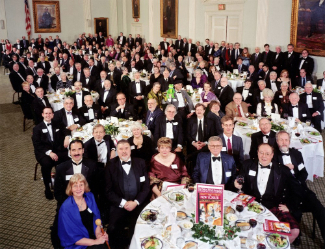
[BSI Dinner 2009 - posted on Facebook by Susan Dahlinger.]
On a personal note, from Wednesday’s ASH Dinner to Saturday morning in the Dealer’s Room to Sunday’s ASH Brunch (hosted by Ms Lyndsay Faye) I’ll be posting regularly on Twitter as @always1895 - and if I can muster up the equipment I’ll have a digital recorder and mic with me in an attempt to emulate the great Sherlockian audioist Bill Rabe, responsible for Voices From Baker Street, making Sherlockian-centric field recordings and conducting impromptu interviews, for both online use and posterity. I’m looking forward to seeing those Sherlockians I only get to hang out with once a year as well as making new friends and forging new alliances, so don’t be a stranger and make sure to say hello. I’m giddy with excitement and I can’t wait for the around the clock Sherlock-o-rama madness to begin!
Canadian Homes Winter 2013/2014 (Volume 36, Number 2) - The Journal of the Bootmakers of Toronto - is now available for download as a PDF and features 36 pages of quality Sherlockian scholarship and news. JoAnn and Mark Alberstat write-up their observations of tourists encountering the John Doubleday bronze Sherlock Holmes statue on Baker Street, Clifford S. Goldfarb and Hartley R. Nathan explore Jewish stereotypes in the Canon (part 2 of a multi-part essay), Elaine McCafferty and Wilfrid de Freitas share some of their insights into legendary Sherlockian Donald A Redmond's work as an author, librarian and Doyle pilgrim, and much more can be found in the latest issue of Canada's premiere journal of Sherlockian scholarship.
[Download the latest issue of Canadian Holmes (Vol. 36, No. 2) from The Bootmakers of Toronto website for free.]
BBC Four announced a Sherlock-centric episode of the documentary program Timeshift titled “How To Be Sherlock Holmes: The Many Faces of the Master Detective" set to air at 10pm (GMT) on Sunday, January 12, 2014. "For over 100 years, more than 80 actors have put a varying face to the world’s greatest consulting detective - Sherlock Holmes. And many of them incorporated details - such as the curved pipe and the immortal line "Elementary, my dear Watson" - that never featured in Conan Doyle’s original stories. In charting the evolution of Sherlock on screen, from early silent movies to the latest film and television versions, Timeshift shows how our notion of Holmes today is as much a creation of these various screen portrayals as of the stories themselves." The narrator of the program is no stranger to the Sherlockian screen having played Langdale Pike in the 1994 Granada adaptation of The Three Gables and Baron Gruner in the 1965 BBC adaptation of The Illustrious Client. Other contributors include Benedict Cumberbatch, Christopher Lee, Tim Pigott-Smith and Mark Gatiss. The Sherlock Holmes Society of London announced on Twitter that their very own Roger Johnson acted as a consultant, a fact that makes me think “How to Be Sherlock Holmes” will rise above the mediocre-to-average Holmes documentaries of the last few years.

[Mark Gatiss who plays Mycroft on BBC Sherlock reflects on Peter Cushing in the role the Great Detective.]
Doyleockian in “Why Was Holmes Resurrected?” demolishes the claim that ACD ‘resurrected’ Holmes in The Strand due to immense pressure from Sherlock Holmes fans at the time. “Holmes came back only because of money. ACD knew that interest in Holmes was already ramped up as a result of the William Gillette play (based on his original) which had already done very well in the US and was due to début in the UK that same year. It was a perfect time to churn out a story and capitalize on the extra hype.” At a time when the most popular Holmes adaptation on TV is captained by Steven Moffat, an undisputed and committed fan of the Canon, it’s difficult to harbor (or even stomach) the thought that the creator of Sherlock Holmes was anything but an ardent believer - in fact ACD considered Holmes a thorn in his side and a diversion from his more important historical fiction. Writing to his mother, ACD said of Holmes: “He takes my mind from better things.” I’ve always thought that the famous Punch illustration by Bernard Partridge (see below) from 1926 sums up ACD’s feelings most accurately: ACD is shown chained at the ankles while a Paget-esque Holmes holds the other end of the chains, opposed to being chained-up to ACD. But as Alistair Duncan points out, Holmes made ACD a very rich man.
[Bernard Partridge illustration from a 1926 issue of Punch, a weekly British magazine of satire and humor - coincidentally many early Punch covers were drawn by ACD’s uncle Richard Doyle, a noted Victorian illustrator.]
Dan Andriacco recently posted a few book reviews, prefacing his latest post with a humorous analysis of the current state of the online world: “Some readers of this blog may have noticed that it has been something of a BBC Sherlock-free zone. While the rest of the Sherlock Holmes blogosphere and Twitterverse have been consumed with Season Three, Baker Street Beat has taken no notice.” Ha! Andriacco is just too cool for school I guess! (I joke.) Instead of rigorously speculating on the meaning of “Redbeard” he reviews The Immortals: An Unauthorized Guide to Sherlock and Elementary (MX Publishing, 2013) by Matthew J Elliot, an analysis of all of the 2012-2013 Sherlockian TV adaptations including plot summaries as well as “Holmes’s notable moments, Notable moments of the police regulars, Identification of material drawn from the Canon, Sex and romantic relationships, Drug references, Logical inconsistencies…” and much more. And for all the Cumberbunnies out there, Andriacco recommends Benedict Cumberbatch in Transition: An Unauthorized Performance Biography (MX Publishing, 2013) by Lynnette Porter. Finally, if pastiches featuring Holmes versus historic villains from literature or history is your thing, Andriacco invites you to check out the graphic novel Sherlock Holmes and the Horror of Frankenstein (MX Publishing) by Luke Kuhns and artist Marcie Klinger. So get off the couch and grab a book and then get back on the couch and do some reading!
[Cover art for Luke Kuhns and Marcie Klinger’s Sherlock Holmes and the Horror of Frankenstein on MX.]
Scuttlebutt from the Spermaceti Press, Peter Blau's legendary list of Sherlockian news, events, etc., is updated through December 2013. Topics include a conference in Davos by The Reichenbach Irregulars in September 2014, a board game based Neil Gaiman's Sherlock/Lovecraft pastiche “A Study in Emerald,” a Sherlock-centric shop on Etsy by Chris Caswell who formerly owned a bookstore in Southern California called Sherlock’s Home, Judith Freeman's index to The Serpentine Muse complete through 2013 as an Excel spreadsheet, and tons more from Peter Blau’s original Sherlock Links list.
[Click here for a PDF of the Scuttlebutt from the Spermaceti Press for all of 2013.]
Sherlock Peoria in “Was Sherlock Holmes a casualty in the War on Drugs?” considers the relationship between Popular Culture (and stoner bookstore clerks) and the perennial question: “Was Holmes a drug addict?” Brad Keefauver’s post was inspired by a recent Twitter post by Martin Montague of a letter ACD’s son Denis Conan Doyle wrote to The Lancet in 1937: “Your contributor’s interesting notes on cocaine poisoning give the erroneous impression that Holmes was a “drug addict”. As a matter of actual fact, my father neither conceived nor depicted Sherlock Holmes as a drug addict. He was represented as one of those rare individuals who use drugs sparingly and occasionally, and who are the masters rather than the slaves of the drug concerned.” Keefauver seems to be of the strong opinion that Holmes was indeed NOT a drug addict, dismissing opportunist Nicholas Meyer's novel The Seven-Per-Cent Solution (1974) and chastising noted Sherlockian Jack Tracy for his Subcutaneously, My Dear Watson (1978) for portraying the Great Detective as a bonafide cocaine addict. Whether you think Holmes was a hopeless dope fiend junky dirtbag or an intellectual dabbler with Herculean will power - there’s textual evidence for both opinions in the Canon - Keefauver’s essay comes at a time when many impressionable young Sherlockian minds are watching adaptations of Holmes as recovering heroin addict (Miller in Elementary); Holmes as reckless drinker of embalming fluid (Robert Downey Jr in A Game of Shadows); and/or Holmes as a three nicotine patches at a time ‘wink wink nudge nudge’ possible drug user (Cumberbatch in Sherlock).
[Denis’ letter to the editor of The Lancet from 1937 - this is my first time reading about Denis’ stance on the Holmes/addict question and now I need to track down the editor’s column that sparked said response. If you’re interested, the Denis Conan Doyle letter pictured above appeared in The Lancet ”Volume 229, Issue 5918, January 30, 1937, Pages 292 Originally published as Volume 1, Issue 5918” which is available online if you have access to an academic library’s online subscription service.]
221B Con - the second annual Sherlock Holmes convention happening in Atlanta, GA on April 4 - 6, 2014 - posted a few announcements and requests this past week: 1) Nicholas Briggs, a producer and actor for Big Finish audiobooks as well as the voice of Daleks and Cybermen in Doctor Who, will be joining the Guest & Performers line-up, 2) 221B Con needs your photos from last year for promotional material, 3) additional comments regarding the 2014 programming list eg. due to the ‘mature’ nature of some panels like BDSM/Kink there will be a late-night, 18 and up programming section (and since the majority of the conference is all-ages the 19+ programming will not be listed on the general schedule) and 4) information about and a request for help for the 221B Con Tea Party (eg. dietary requests, games, cosplay ideas). Attendees from last year are still raving about 221B Con so mark your calendars, book you plane/train/bus ticket and start sewing your cosplay costume! For a taste of what to expect, check put the edifying and amusing audio recordings from 221B Con 2013 on the Baker Street Babes website.
[Nicholas Briggs as Sherlock Holmes in The Ordeals ofd Sherlock Holmes Box Set on Big Finish.]
Scintillation of Scions VII, happening June 6 - 7, 2014 in Hanover, Maryland (outside of Baltimore), announced the line-up of speakers for their seventh annual gathering of Sherlockians called to order by organizer Jacquelyn Morris. If I didn’t have to recuse myself for being among said list, I would be forced to admit that it’s quite a distinguished group of Sherlockians, leaning heavily towards Sherlockian Internet/online personalities that you know and love (or ‘hate’ if you’re CBS’s Elementary production staff) as well as stellar Sherlockians from a variety of backgrounds. Speakers include: Jan Burke, Carla Coupe, Brad Keefauver, Toni L.P Kelner, Matt Laffey, Scott Monty, Ashley Polasek, Lynne Stephens, Karen Wilson & Stephen Welbourn and Vincent W. Wright. Register early to ensure a place at what is quickly becoming one of the most respected yearly Sherlockian conferences.
[Stay tuned for information on what this diverse group of Sherlockians will be discussing in the coming weeks.]
Sherlock Holmes And The Mystery of Einstein’s Daughter by author Tim Symonds is the perfect remedy for pastiche fans who are a bit tired of the usual Sherlock Holmes versus ‘insert famous historical villain here’ tropes; instead Symonds challenges Holmes in new and exciting ways: “The Dean of a Swiss university persuades Sherlock Holmes to investigate the background of a would-be lecturer. To Dr. Watson it seems a very humdrum commission - but who is the mysterious ‘Lieserl’? How does her existence threaten the ambitions of the technical assistant level III in Room 86 at the Federal Patents Office in Berne by the name of Albert Einstein?”
[Sherlock Holmes and the Mystery of Einstein’s Daughter (MX Publishing, 2014) by Tim Symonds.]
Sherlockian Sherlock - everyone’s favorite Hungarian Holmes website - not only keeps the memory of the Great Detective green, but is also concerned with keeping said memory true and accurate. In “Common Misbeliefs About Sherlock Holmes” the authors tackle 24 widespread misbeliefs and misconceptions about Sherlock Holmes. Misconceptions dispelled range from serious accusations such as ‘Holmes was racist’ or ‘Holmes used drugs all the time’ to the slightly more mundane like ‘Holmes was a handsome man’ or ‘Holmes was untidy’. Slightly more controversial topics tackled include Holmes’ religious beliefs and Holmes’ sexual orientation; though many are classic Sherlockian topics such as Holmes’ ontological status, the origins of “Elementary, my dear Watson” and whether or not Holmes had Asperger’s Syndrome. Perhaps the most timely issue addressed is whether adaptations which depict Holmes in a contemporary setting damage or detract from the essence of Sherlock Holmes. Whether you agree or disagree with the various points, you’ll certainly appreciate the sincerity and seriousness in which these Hungarian Sherlockians defend their beliefs.
[24 Misconceptions about Sherlock Holmes dispelled by the editors of Sherlockian-Sherlock, dedicated and passionate Sherlockians from Hungary.]
January 6, 2014
January 4, 2014
Weekly Sherlock Links Compendium (December 14 - December 31, 2013)
Here’s my final set of Sherlockian news items and happenings from 2013….
The summary judgment on Klinger vs. Conan Doyle Estate Ltd. was announced, Les Klinger and an attorney for the ACD Estate both responded to the ruling, intellectual property expert and Sherlockian Betsy Rosenblatt explored what the Free Sherlock ruling means for fans, I Hear of Sherlock Everywhere released a special edition podcast discussing all things #FreeSherlock, The Grand Game trading card project set-up a Kickstarter page, Sherlock Holmes meets Doctor Who, Dan Andriacco commemorates Blue Carbuncle Day, an issue of The Solar Pons Gazette appeared after a five year hiatus, Ross K Foad started an online collection of Sherlockian essays called the Diogenes Club Library, the British Library uploaded over one million public domain images to Flickr, Kristina of the Baker Street Babes makes the case for why you should love Sherlock, Alistair Duncan reported on a controversy sparked during a pre-screening of The Empty Hearse, what happens when 12 Sherlockians get together online to collaborate on a pastiche, MX Publishing put together a list of their 99 favorite Sherlock-related books and Season 3 of BBC Sherlock premiered in the UK and more in the final Weekly Sherlock Links Compendium of 2013 by Matt Laffey.

Free Sherlock vs Sherlock Copyright Holders - known legally as “Leslie S. Klinger vs Conan Doyle Estate, Ltd.” - has come to a conclusion after 10 months of legal wrangling, acrimonious message board rants and a fair amount of amateur legal speculation one might expect from an intellectual property case lodged at the intersection of internet pop culture and a long and storied history of copyright controversy. Perhaps the most news worthy Sherlockian story to appear in the final days of 2013 (if you don’t count that ‘other’ piece of news about the air dates for a certain Holmes adaptation featuring a certain dreamy Sherlock), it’s a tangled skein best left to the experts to interpret and explain. From FreeSherlock: “The ruling is a victory for the plaintiff Leslie S. Klinger, who sought to establish that the Estate was wrong in claiming that no new stories could be written about Holmes or Watson without the Estate’s permission. “Sherlock Holmes belongs to the world,” Klinger said. “This ruling clearly establishes that. Whether it’s a re-imagining in modern dress (like the BBC’s Sherlock or CBS-TV’s Elementary), vigorous interpretations like the Warner Bros. fine Sherlock Holmes films, or new stories by countless authors inspired by the characters, people want to celebrate Holmes and Watson. Now they can do so without fear of suppression by Conan Doyle’s heirs.”” You can read a PDF of the entire “Order on the Motion for Summary Judgment" here which may sound kind of boring, but out of all the material that’s available online regarding Klinger vs Estate, this will give you the best sense of 1) what the actual dispute is about and what it is not about, 2) what Klinger and ACD Estate agree on, 3) what Klinger and Estate do not agree on, 4) why Klinger thinks ‘elements’ from post-1923 stories are not protected, 5) why the judge thinks Klinger is wrong on #4 because what Klinger calls “elements” are in fact protected as characters, plots, etc. and 6) what some of the implications are for authors and publishers.
[Plaintiff Les Klinger in his LA law office surrounded by the spoils of a life dedicated to the Great Detective. When not annotating things or attempting to thwart copyright laws Klinger is an attorney in California and I sometimes wonder if new clients of his, encountering an office packed with Sherlockiana, are instilled with extreme confidence (ie. Sherlock Holmes was like a giant brain so my attorney must be a giant brain!) or extreme concern (ie. when does this guy have time to work on lawyer stuff?).]
Counsel for the Conan Doyle Estate Ltd. Benjamin Allison reacted and interpreted the ruling a bit differently than Klinger in “Ruling Continues to Protect Much of Sherlock Holmes’s Character; Conan Doyle Estate Considers Appeal” pointing out that “under the current ruling from the Chicago trial court, all development of the Holmes and Watson characters by Sir Arthur in ten post-1922 stories remain fully protected by copyright. These ten stories - set at a variety of earlier points in the two men’s fictional lives - contain significant elements of both characters, including Sherlock Holmes’s mellowing personality, the change in Holmes’s and Watson’s relationship from flatmates and collaborators to closest friends, and a host of other developments, skills, and elements of background. While plaintiff Leslie Klinger sought a ruling that some of these character traits were free for all to use, the Court rejected Mr. Klinger’s effort in this regard and held that all such characteristics of Holmes and Watson are protected.” Allison makes an interesting point that helps frame the scope of why any of this actually matters: “Nearly a third of the stories in Mr. Klinger’s first co-edited story collection, A Study in Sherlock, use protected post-1922 story elements. That book’s publisher, Random House, appropriately entered into a modest licensing arrangement with the Estate despite Mr. Klinger’s position against such a license. Mr. Klinger did not provide his second story collection to the Estate, but one of the writers for that new collection told the Estate he wished to use a protected character, Langdale Pike, from the post-1922 stories. The Chicago Court reiterated that the character is fully protected by copyright law.” If I was a rumor mongering blogger-type I might mention something like: rumor has it that the catalyst for the entire copyright hullabaloo was a casual mention of Langdale Pike…and the rest is legal history.
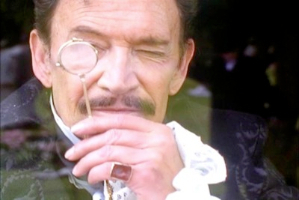
[ as Langdale Pike in the Granada adaptation of “The Three Gables.”]
Betsy Rosenblatt posted an essay on the Baker Street Babes website exploring some of the real-world implications of the #FreeSherlock ruling in “What does the Free Sherlock ruling mean for fans?” I encourage anyone unclear about various aspects of this case and/or anyone interested in reading a fascinating enumeration of the more pragmatic ins and outs of the case. My personal favorite bit in Rosenblatt’s essay concerns a Canonical point the judge got wrong, which also illustrates a bit about the limitations of the ruling (in both directions): “Keen Sherlockian eyes will observe that the judge got one point factually wrong: Sherlock Holmes’ retirement was first described in “His Last Bow" (one of the public domain stories), not the 1926 "Lion’s Mane”. What does that factual error mean for fans? Probably not much, since this factual finding won’t bind future courts. Based on the legal principle articulated in the case, Holmes’s retirement to the South Downs, on a small farm among his bees and books, including The Practical Handbook of Bee Culture, with some Observations upon the Segregation of the Queen, are in the public domain - but the details of his retirement setting, and (of course) the storyline of “The Lion’s Mane”, are still protected.” If you’re still having difficulty explaining the finer points of Klinger vs ACD Estate to your friend who keeps on asking whether or not he can start writing a Fifty Shades of Grey-Sherlock parody, see the NY Times article “Sherlock Holmes Is in the Public Domain, American Judge Rules" (with accompanying Frederic Dorr Steele illustration) for further analysis.
[Sadly, your other friend’s slash fanfic featuring Sherlock and the jellyfish from LION cannot be published in the U.S.A. without paying a fee to the Conan Doyle Estate until 2022.]
I Hear of Sherlock Everywhere, on a related #FreeSherlock note, released a special podcast episode of IHOSE covering the Klinger vs ACD Estate ruling featuring interviews with the plaintiff himself Les Klinger as well as IP Law scholar and noted Sherlockian Betsy Rosenblatt (BSI, ASH): “We were once again joined by Les, who outlined the background of the case and discussed some of the legal aspects of copyright that have led us to this juncture. We try to keep the discussion as interesting as possible for the lay people out there, and Les even manages to bring in the 1902 coronation of Edward VII as part of the case law history….[and] Betsy touches on some additional points that will undoubtedly be of interest.” Instead of ending the show with a relevant Baker Street Journal ’Editor’s Gas-Lamp’ Scott and Burt read from the late Joseph Merriam's musings on “the impact of the legal profession within the Sherlock Holmes stories, citing six separate examples of the law and lawyers within the Canon.” Originally presented at a Spring 1992 meeting of The Speckled Band of Boston, Merriam’s essay is available online as a handwritten document titled “Impact of the Law on the Sherlock Holmes Stories" and is a hoot to read.
[A scene from The Coronation of Edward VII (1902), a short film by George Méliès and Charles Urban which reenacts the coronation of King Edward VII and Queen Alexandra. Watch the short film in it’s entirety here. ]
The Grand Game, the fan-inspired Sherlockian trading card project first announced here in October, is close to completion but needs your assistance! “With your help we can move this project to the final stages. We have been able to develop and design the first set of the cards honoring the fans of Sherlock Holmes. It is our hope that it will be the first of many sets to come” Collectors interested in the project might consider donating at the $150 level for which they’ll receive a Hobby Box (10 packs of cards) of The Grand Game - Sherlock Holmes Trading Cards w/ one box redemption (a $200 value). There’s also an accompanying eight minute video narrated by the creator of the card project, second generation Sherlockian Brian Rogers, which explains the history and philosophy behind The Grand Game Trading Cards, a myriad of gorgeous artwork examples and details on how you can help. To learn more about the project itself, read through the Kickstarter page and check out The Grand Game on Facebook and follow their Twitter for updates and special offers.
[Les Klinger’s trading card from The Grand Game, Series One.]
Sherlock Meets the Doctor (released December 11, 2013), the fan mashup video sensation released which brilliantly and seamlessly merged footage from BBC Sherlock and Doctor Who (Matt Smith), was all the rage this December garnering attention from sites as diverse as the Huffington Post to Yahoo TV to Tor as well as pretty much every Sherlock and Doctor Who blog in existence, winning almost unanimous support from both fandoms, as the Internet seemed to shout in unison “Best Fan Video Ever!”, an assessment that’s pretty close to the mark. If you’re interested in how the video was created as well as a look at the original shots used, see Wholock - VFX Breakdown.
[Sherlock Holmes + Doctor Who = Look out all time and space!!]
Dan Andriacco celebrates that most Sherlockian-specific of holidays, Blue Carbuncle Day, better known as “the second day after Christmas”(BLUE). In “Saving Mr Baker” Andriacco muses “Do you ever wonder what happened between Mr. Henry Baker and his wife after he walked off the pages of “The Blue Carbuncle” with his replacement goose?” I’ll see Andriacco’s question and raise him another one: Do you ever wonder what happened to the upper-attendant of the Hotel Cosmopolitan, hapless schlemiel Mr James Ryder, the de facto villain of the piece. Ryder is systematically tracked down by Holmes, lured to 221B and then cajoled into a confession, only to then throw himself upon Holmes’ mercy. Following one of the most pathetic scenes in the Canon (cf. Paget illustration below) Holmes, ostensibly moved by ”the season of forgiveness,” pardons Ryder. Immediately following Ryder’s departure, good old predictable Watson expresses his middle class outrage at Holmes (once again) taking the law into his own hands, only to be appeased by Holmes’ ‘jailbird for life’ explanation - an explanation I’ve always found questionable in light of one, it’s rather loose logic and two, Holmes’ earlier stressing of ”the season of forgiveness”. In short, I’ve always thought this scene is one of the greatest counter examples to the argument that Holmes is nothing but “the most perfect reasoning and observing machine”.
[“Ryder threw himself down suddenly upon the rug and clutched at my companion’s knees. “For God’s sake, have mercy!” he shrieked. “Think of my father! of my mother! It would break their hearts. I never went wrong before! I never will again. I swear it. I’ll swear it on a Bible. Oh, don’t bring it into court! For Christ’s sake, don’t!”” (BLUE).]
The Solar Pons Gazette (December 2013, Vol 4.1 No 5), published by Bob Byrne, is the newsletter dedicated to American mystery author August Derleth's detective Solar Pons, described as “the best substitute for Sherlock Holmes known” by the godfather of all things Sherlockian Vincent Starrett. The last issue of The Solar Pons Gazette was released over 5 years ago but as editor Bob Byrne explains “after a long break from the work of August Derleth, I’ve returned to the deerstalkered demesne of the Sherlock Holmes of Praed Street. I kick it off with my ‘second’ introductory essay on Pons.” The 44 page December 2013 issue is packed with commentary on classic Pons adventures, a Solar Pons pastiche, excerpts from the notebooks of Pon’s sidekick (ie. his Watson) Dr Parker, an old essay by Chris Redmond (of Sherlockian.net fame) from The Pontine Dossier (1977, Vol. 2 No. 3) and a reprint of an essay that should be of interest to both Derleth and Lovecraft fans entitled “Solar Pons and the Cthulhu Mythos.” To learn more about August Derleth, visit the August Derleth Society’s website at: http://www.derleth.org. If you’ve never stopped in at 7B Praed Street, your first adventure with Solar Pons and Dr Parker can feel eerily familiar, like returning to the neighborhood you grew up - while you’ll have no problem finding your way around, the details and scale are ‘off’ just enough, producing a sense of temporary vertigo that mostly clears allowing you to enjoy the trip as a novelty, but not quite as home. Regardless, it’s still a treat occasionally spending time in Derleth’s world which is so lovingly modeled after the more familiar environs of Baker Street.
[Back from a five year hiatus, The Solar Pons Gazette is the official newsletter of www.SolarPons.com (to be relaunched soon), both of which are maintained and edited by longtime Ponsian Mr Bob Byrne.]
Diogenes Club Library, a new concept/project from Ross K Foad of No Place Like Holmes, seeks to be “the reading room of the site and houses an easy to navigate place for the essays NPLH has published so far (including all of Howards Ostrom’s ‘Silent Doyle’ essays mentioned previously on Always1895). Ross K is actively seeking scholars and enthusiasts alike who might be interested in seeing work of their own on a larger platform in submitting essays for consideration at moment.” Ross K’s project has all the makings of an excellent online Sherlockian resource that will benefit Holmes fans of all persuasions.
The British Library announcement that they’ve uploaded “one million public domain scans from 17th-19th century books to Flickr! They’re embarking on an ambitious programme to crowdsource novel uses and navigation tools for the huge corpus. Already, the manifest of image descriptions is available through Github.” I’ve ran a few preliminary searches and since most of the scans are from books that pre-date the publication of A Study in Scarlet there’s not much in the way of Sherlock Holmes or ACD material beyond The Strand and Sidney Paget illustrations from The Adventures and The Memoirs but I’m sure the corpus will provide plenty of excellent and useful material one might use for a variety of research projects.
[Image taken from page 133 of Cook’s Handbook for London, just one of the million pictures available for free from the British Library corpus.]
5 Reasons Why You Should Love Sherlock video put together by Kristina of the Baker Street Babes celebrates the very imminent return of BBC Sherlock. Lyndsay Faye and an assortment of other Babes assist Kristina in reviewing just why you should love the Great Detective: “From canonical references to otterlock, it has it all.”.
Doyleockian reports on events surrounding the pre-screening of The Empty Hearse on December 15, 2013 at the BFI in London - an event that will be remembered for time immemorial (or at least for another Internet cycle or two) for igniting a controversy based not on the audience’s reaction to the BBC Sherlock Season 3 premier, but for a series of comments made /questions asked by one of the Q & A hosts, Caitlan Moran. London Reviews covers the entire ‘story’ but the gist of it seems to be that Moran, who was supposed to be moderating the panel by asking questions related to the episode just watched, asked a set of silly, rude and unrelated questions and then proceeded to read aloud an example of Sherlock fanfiction she found ‘funny’ - without the permission of the author whose thoughts on Morangate can be read here - but turned out to be ultra explicit making the crowd and panel (Cumberbatch, Moffat, etc.) uncomfortable. As you might expect, Twitter and other Sherlock fandom frequented social media sites reacted immediately and throughout the next few days. A few days later Alistair Duncan followed up his original post with some comments about the ‘Morangate’ fallout, and that’s about all there is worth reporting. Make of this what you will. In the grand scheme of Sherlockian things happening over the next month or two it’s just an insignificant Internet blip that is sure to be overshadowed and then forgotten.
[Q & A panel at the BFI pre-screening of The Empty Hearse.]
Girl Meets Sherlock, a blog by Amy Thomas, posted “2013: Sherlockian Year in Review” featuring personal Sherlockian highlights including the publication of her second pastiche The Detective, The Woman and The Winking Tree on MX and her one year anniversary as a Baker Street Babe as well as general Sherlockian fun such as 221B Con and Save Undershaw with a last minute inclusion of The Adventure of the Crowd-Sourced Adventure (cf. next entry) which occurred in the last days of 2013.
The Adventure of the Crowd-Sourced Adventure, written via Facebook in a two-hour period on December 29, 2013, is a collaborative effort by the following group of Sherlockians: Susan Bailey, C. A. Brown, Lindsay Colwell, Eva Garcia, Elinor Hickey, Jennifer Ribble Jones, Jaime Mahoney, Trix Middlekauff, Chris Redmond, Amy Thomas, Ray Wilcockson and Vincent W. Wright. “The waning days of December 1895 brought with them one of the most remarkable and yet untold cases in Sherlock Holmes’s career, which began one cold, foggy evening as I was preparing to depart the consulting-room of my medical practice and was startled by an unexpected knock on the door….” You can read the entire text at Sherlockian.net.
MX Publishing's owner Steve Emecz's collected his 99 favorite Sherlock-related books, which are all available on Amazon, and displayed the front covers via his Pinterest page. On a related note, Steve and his wife have spent their Xmas/holiday in Kenya researching a book on a project called ‘Happy Life’: “an ambitious project in Kenya that has already saved and had adopted over 160 abandoned children from the slums of Nairobi. The Happy Life Story book will share the success of the program and be a great resource for prospective adoptive parents full of case studies and information on how the project has grown…And of course we’ll make sure that there will be plenty of Sherlock Holmes books for the older children….” Check out their Kickstarter page for details.
[My favorite 2013 MX Publishing release: The Lighter Side of Sherlock Holmes: The Sherlockian Artwork of Norman Schatell edited by Glenn Schatell.]
BBC Sherlock Series 3 (Spoiler-Free) Links:
BBC, as every Sherlockian fan in the universe is now aware, announced at long last the air dates for the The Empty Hearse, the Season 3 premier of BBC Sherlock. Viewers in the UK get to find out just how Sherlock survived Holmes’ plunge off the roof of St Barts on January 1, 2014 at 8pm, but North American fans will have to wait until January 19, 2014 when the episode officially airs on BBC America. By the time you’re reading this, The Empty Hearse will have already aired in the UK - hence available online for those with the ability and moral laxness to download TV shows illegally - but I’ve held off including any information in this post about the episode so as not to ruin any surprises or reveal any spoilers for those waiting to watch on Sunday, January 19th (which happens to be the final day of BSI Weekend 2014 in NYC).
[#SherlockLives!]
Many Happy Returns, for those of you living under a rock, is a seven minute Sherlock ’mini-episode’ released by BBC on Christmas day entitled Many Happy Returns featuring events from after the Series 2 finale The Reichenbach Fall leading up to those in The Empty Hearse. After two years of waiting, Team Moffat delivers up a small slice of Sherlock heaven replete with Season 3 teasers, hilarity and Canonical tidbits galore.
[Where in the world is Sherlock Holmes?]
December 13, 2013
Weekly Sherlock Links Compendium (December 7 - December 13, 2013)
WWJBSD? (What would John Bennett Shaw Do?), IHOSE interviews the minds behind Sherlockology, the high price of living at 221B Baker Street, Peter Blau’s Scuttlebutt, things that make a Sherlockian happy, the most Irregular Irregular and a Prince among men, missing pieces from The Private Life of Sherlock Holmes, an interview with the actors of the Baskervilles, Holmes’ methods in the modern police age, where to spread the compliments of the season, the proper way to kickoff BSI Weekend, gifts for Sherlockians, the dancing cookies and much more in the latest Weekly Sherlock Links Compendium from Matt Laffey.
Birthday Week is approaching fast - and to get psyched up for it here’s the first official BSI Dinner group photo ever. Taken at the legendary Murray Hill Hotel in 1940, attendees included luminaries such as all three Morley brothers (Chris, Felix & Frank), Howard Haycraft, Basil Davenport, Robert K. Leavitt, Edgar W. Smith, James P. Keddie and Frederic Dorr Steele (!), plus one attendee who, as of 1998, was still alive: Mr Ronald Mansbridge, the fourth guy from the bottom on the left side with mustache. I absolutely love reading about the history surrounding these dinners, but 1940 was particularly important for a myriad of reasons, all of which can be read about in Jon Lellenberg's excellent essay “Entertainment and Fantasy”: The 1940 Dinner. Stay tuned to Always1895 for more BSI Week history as we countdown the days to January 15, 2014….
Weekly Sherlock Links Compendium - December 7 - 13, 2013
The Sherlockian E-Times (Vol.13 No.12 December 2013) from Carolyn and Joel Senter features an essay by Ron from Denver about what he learned from uber collector John Bennett Shaw in regard what it means to be a Sherlockian: “I was fortunate to meet and know John Bennett Shaw, who had the largest individual Sherlockian collection in the United States and was one of the kindest, most decent human beings I had the pleasure to know. In my too few visits by letter and in person, we discussed all things Sherlockian. The following points are concepts I took away from my conversations with John Bennett.” My favorite point from Ron’s list is #1 “If you have one of a Sherlockian collectible, you gloat. If you have two, you share.” I have the feeling that within Sherlockian culture we’re about to experience a JB Shaw (“The Hans Sloan of My Age”) zeitgeist of sorts as younger Holmes fans who are just discovering the wide world of Sherlockian scholarship and Sherlockian history learn of the role Shaw played in the development and growth of US scion societies. Edgar Smith may have been the Chief organizer of early Sherlockian culture, using his GM management skills to lay the foundation for the modern BSI, but Shaw was the Johnny Appleseed of scion culture, playing St Paul to Smith’s St Peter, marching out into the field and inspiring one local chapter after another via a ‘big tent’ approach where everyone and anyone interested in the Great Detective could/should get involved.
[JBS in his study with non-canonical calabash and book.]
I Hear of Sherlock Everywhere released ‘Episode 59: Sherlockology’ - “We can unabashedly say that we’re huge fans of Sherlockology. So it was with great pleasure that we sat down with Jules Coomber and David Mather, two of the four (in addition to Emma and Leif) who run the burgeoning online presence of a site that pays homage to the BBC’s Sherlock and the cast and crew that are responsible for it. It’s been so well done that many think that it’s either an official BBC site or that it’s only about the show.” Moving on, Scott and Burt implore their listeners to order a gift subscription to the Baker Street Journal - a suggestion I wholeheartedly endorse - for friends, family, strangers, libraries, schools, etc., even offering to reward the gifters with a modest Sherlockian treat if at least 50 gift subscriptions are ordered. In other news, Wessex Press’ triennial conference From Gillette to Brett IV: Basil, Benedict and Beyond happening September 12-14, 2014 will feature a Sherlockian Relics of Stage, Screen and Radio Exhibit., just one of the many aspects of this conference you’ll be hearing more about right here. Lastly, the 59th IHOSE podcast ends on a Xmas themed Editor’s Gaslamp from the father of Sherlockian culture in the United States, Edgar Smith with his 1959 BSJ Xmas Annual piece “Christmas With Sherlock Holmes” which celebrates that time of year when every Sherlockian worth his or her canonical salt revisits “The Adventure of the Blue Carbuncle" and wishes their fellow Holmes-fanatics the compliments of the season, ending with: "and Christmas is a window too, that opens on the hearts of men, to make them young and glad again."
[“The ultimate guide for any BBC Sherlock fan!” Indeed.]
Sherlockology - now that you’re thoroughly familiar with the minds behind Sherlockology from their IHOSE appearance above - presents a remarkably in-depth and fascinating look at how much it might cost to be a resident of 221B in the BBC Sherlock-verse via a set of intriguing and creative infographics. Everything from John and Sherlock’s wardrobes to the more memorable contents of their flat are itemized and priced. Also discussed are costs associated with home insurance (clearly needed), based on some of the events of Seasons 1 and 2; eg. bullet holes in living room wall (The Great Game), broken windows (ibid.), etc. (Estimates based on Confused.com data). This post is deliciously typical of Sherlockology’s creative passion when it comes to discussing aspects of BBC Sherlock well outside the typical ‘fan-talk’ of the majority of sites one’s likely to come across on the internet. In light of Sherlockology’s recent appearance on IHOSE Ep. 59, it’s no surprise that the site continues to develop creative and original content, ostensibly based around a paltry six episodes (soon to be nine) but robust and clever enough to reach Holmes enthusiasts well outside the limited scope of a single TV adaptation. Finally, make sure to follow @Sherlockology and become one of their 173,000+ followers on Twitter - and not to brag, but I’m terribly proud to point out that @always1895 numbers among their rigorously curated ‘Following' list comprised of a magical two hundred twenty-one Twitterers.
[Just a portion of this unique and amusing set of infographic charting the ‘cost’ of being a denizen of 221B Baker Street in the BBC Sherlock universe. I had no idea that the iconic Sherlock/Cumberbatch coat was in the Duke of Holderness price range at £1350 (or $2,209)! ]
Scuttlebutt From the Spermaceti Press from Peter Blau is available and chocked full of Holmes-related information including BSI Week events, info on the quirky yet entertaining recent (re)appearance of ‘Sherlock Holmes’ on Murdoch Mysteries ”Return of Sherlock Holmes" (7x04) which also features a cameo by literary agent ACD portrayed as an idea ‘borrower’, a reminder that the "Edgar Allan Poe: Terror of the Soul" exhibit is still running at the Morgan Library in NYC (until January 26, 2014), remembering recently departed Sherlockians Gerald N. Wachs (“Sir James Saunders”) and Barbara Hicks (who among other accomplishments played Emily Garrideb in Granada’s 1994 3GAR adaptation), an update on Moriarty, N.M. where the legendary Moriarty Un-Happy Birthday and Moriarty Memorial Manure Pile led by John Bennett Shaw took place (watch scenes of the mid-1980s event in this recently posted doc The Case of Sherlock Holmes (1987) - a must see!) and much much more. A special thanks to Mr Blau for mentioning my Always1895.net post “Full Recording of ‘The Secret of Sherlock Holmes’.” in his November 13, 2013 edition of Scuttlebutt.
[“Black Peter” has been publishing his Scuttlebutt From the Spermaceti Press newsletter since 1971, just 6 years before I was born.]
The Consulting Detective created a list entitled “Top 5 Things that Have Made Sherlockians Happy” featuring such items as Canonical easter-eggs in the two Robert Downey Jr films (eg. “Come at once if convenient…if inconvenient come all the same.”), Titan Books re-release of a myriad of classic pastiches, recent Sherlock references on Doctor Who, and more. Personally, none of these items would make my Top 5 - maybe a few would linger somewhere around the lower end of my top 30 - but this list is something that makes me happy as a Sherlockian because it stresses the interest the author Nick Cardillo has in the Canon, even if it’s the Canon in the context of the Warner Bros films, the 11th Doctor donning a deerstalker or BBC Sherlock. There’s no denying that 2014, or at least the first quarter of 2014, will be awash (some might say drowned) in BBC’s adaptation of the Master - but as long as the real and the true (and the forever sacred) inspiration (ie. the original 60 stories) for this or any Holmes adaptation remains relevant, his memory shall remain green and “these two survive.”

[The classic note written by Holmes to Watson from CREE.]
Sonia Fetherston has alerted me to one of the most exciting bits of Sherlockian publishing news I’ve heard all year: Ms Fetherston has just completed her draft of a biography on legendary Sherlockian Bliss Austin: Prince of the Realm: The Most Irregular James Bliss Austin (2014) - ”the book features new material, new interviews, newly revealed letters and other documents and photos” and is being published on the BSI Biography Series imprint (general editor Les Klinger). You may recall Fetherston from her 2012 BSJ Christmas Annual Barrymore In Baker Street: “The Great Profile” Meets “The Great Detective,” and They Both Get Their Names Up In Lights, a terrific look at actor John Barrymore who played the Great Detective in Sherlock Holmes (1922). Bliss Austin, an executive for US Steel, amassed one of the finest collections of Japanese woodblock prints as well as collections of Sherlockiana at the time. Jon Lellenberg, in his 1988 obituary of Austin, sums up rather succinctly the role Austin played in Sherlockian culture: “If the Baker Street Irregulars represent Sherlockiana’s aristocracy, Bliss was a gracious and courtly Prince of the Realm. He exemplified for others what it meant to be an Irregular of the old school.” Stay tuned for more information about Fetherston’s Prince of the Realm as well as a future post on Bliss Austin’s various publications.
[Sonia Fetherston’s 2012 Xmas Annual on Holmes actor John Barrymore.]
Cinephilia and Beyond discusses Billy Wilder’s The Private Life of Sherlock Holmes, particularly the discrepancy between Wilder and co-writer IAL Diamond’s original 3 hour script versus the final, studio mandated 93 minute version: “Billy Wilder spent 7 years with his co-writer I. A. L. Diamond working on the script of The Private Life of Sherlock Holmes. The finished film originally lasted over 3 hours, but the studios panicked over the failure of such long form films and demanded cuts. The film was hacked down to an acceptable 93 minutes. Diamond didn’t speak to Wilder for almost a year….The film was originally structured as a series of very specifically structured linked episodes, each with a particular title and theme. The opening sequence was to feature Watson’s grandson in London claiming his inherited dispatch box from Cox & Co. and there was also a flashback to Holmes’ Oxford days to explain his distrust of women….he episodic format made the pruning process relatively simple, so cut were the opening sequence, the Oxford flashback and two full episodes entitled “The Dreadful Business of the Naked Honeymooners” at 15 minutes and “The Curious Case of the Upside Down Room” at 30 minutes. We can only hope that the full footage can one day be restored, although a full print is not currently thought to exist.” As long time readers will recall, the masochist in me enjoys reading about ‘what could have been’ when it comes to Wilder’s The Private Life - contained in at least one commercial release of the film (the Lasdisc release) is the audio for one or two of the cut scenes, along with stills from “The Upside Down Room”.
[Luckily the above scene from the first act of the film featuring an inebriated Watson wondering “what happened to the girls” was thankfully not cut.]
Q&A With the Cast of the Hound of the Baskevilles features a transcript plus video highlights with Director Tom Ridgely and actors Brennan Caldwell, Sean Harris and Rich Hollman. The Hound stage adaptation “runs until Dec. 22 2013 at Playhouse on Park in West Hartford, Connecticut. The play offers a funny take on Sir Arthur Conan Doyle’s most celebrated Sherlock Holmes story. We sat down to talk about the show… Q: What is the screenplay like? What can the audience expect to see as you bring this to life from the novel? Tom: It’s a three actor adaptation from a British company called: People Like Us. A lot of the fun is watching the actors take on the challenge. There’s a virtuosity required in taking on the play and seeing the actors rising to the challenge.” For more information and tickets, check put the Playhouse on Park. For a review of the play, see The Examiner.
[If you live in or near Hartford, CT you should try to check out what sounds like a fun take on The Hound of the Baskervilles.]
Sherlock Holmes Society of St Charles considers the age old dilemma of whether the ends justify the means: “In BLUE we see Holmes not only being the investigator, but also the judge and the jury of Ryder, allowing him to go free at the end. We will never know if it was the right decision, it never came up again. Did Ryder stay on the straight and narrow and leave the country, go to America where he made good and eventually his descendant’s started the Ryder truck rental company and are now wealthy?” Taking this question a step further, we’re asked to consider events in a recent episode of Elementary ”Tremors” (2x10) wherein certain courses of action made by Elementary's Holmes leads semi-directly to a colleague getting shot: “I think it is brave of Elementary to take the examination of Holmes’ methods a step further by examining the methods under the light of someone getting injured that is not the story-teller. We see a police force a little more intelligent than Lestrade and his peers, one that recognizes the need for restraint when you are hired as a consultant. It asks; Would Holmes methods work in a modern police age?" Sherlockians have been debating questions related to Holmes’ somewhat unorthodox techniques for decades. Is Holmes truly a special case, hence allowed to occasionally work above/beyond the law - or should he, regardless of the successes achieved, be chastised or censored after cases like BLUE or CHAS, the latter being perhaps the most extreme example of Holmes’ ‘above the law’ tendencies?
[Ryder at the mercy of Holmes.]
CultBox announced that to “celebrate the return of Sherlock next month, we’ve got sets of BBC Books’ new official tie-in editions of Sir Arthur Conan Doyle’s classic stories - Sherlock: The Return of Sherlock Holmes and Sherlock: His Last Bow - to give away to 4 of our Twitter followers! For a chance to win, just follow CultBox on Twitter and tweet the following text….Follow @cultboxtv and RT for a chance to win 4 x sets of ‘Sherlock’ books.” The Return of Sherlock Holmes features an introduction by Mark Gatiss and His Last Bow features an introduction by Steven Moffat.
[Click for details on how you can win these two new ‘BBC Editions’ of Return and Last Bow.]
Den of Geek posted part 2 of their 3 part interview with BBC Sherlock creators Steven Moffat and Mark Gatiss (totally spoiler free): Q: Why do you think that relationship [between Sherlock and John] has worked so well, you’ve really bulked it up from the books, haven’t you? SM: I think it’s actually very, very faithful to the books. It’s just that oddity of a very close male friendship, which of course is very hard to write about because men don’t talk about relationships ever, and certainly two blokes who are friends with each other will not sit down and talk about their relationship.”
Sherlockian Scion & Event Links:
The Three Garridebs of Westchester County hosts their Annual Blue Carbuncle Luncheon on December 29, 2013 at An American Bistro, Tuckahoe, NY. Join fellow Sherlockians from upstate New York and the surrounding area as the ‘compliments of the season’ becomes the phrase du jour for the duration of the afternoon - along with talk of the proper colour of carbuncles, crop physiology and exactly how much one can conceivably deduce from a seedy felt hat.
[What can you deduce from this old “seedy and disreputable hard-felt hat”? (BLUE)]
Adventuresses of Sherlock Holmes (ASH) will, per venerable custom, usher in the 2014 BSI Birthday Weekend with an informal gathering on Wednesday, January 15, 2014, dubbed ‘a special ASH Wednesday’, at 6:30 PM upstairs at O’Casey’s. “This will be a happy occasion to meet with (and eat with and drink with) kindred spirits from around the globe. As usual, there is no set charge - we each pay for what we consume. If you can attend, please advise either Eveyln Herzog (herzogbaesch[at]aol.com) or Susan Rice (susan221bee[at]gmail.com). All are welcome!” This organization and this event holds a special place in my heart since the Special ASH Wednesday of 2011 was not only my first BSI Week event, but my very first Sherlockian event ever. Now, only four years hence, walking into this BSI Weekend kick-off event is the equivalent of attending a family reunion, as Sherlockians from near and far meet, re-meet and make plans for the days ahead. If you’re a first time BSI Week attendee, Special ASH Wednesdays is the perfect place to introduce yourself and become acquainted with your Sherlockian comrades in the relaxed and welcoming environs of an Irish pub adorned with portraits of famous Irish authors and packed with a hundred or so gregarious and excited Sherlock enthusiasts.
The (Curious Case of the) Watson Intelligence runs through December 29, 2013 at Playwrites Horizon in NYC. You can still purchase tickets (enter code WATPBE for discount). One of the three actors in the play is , which fans of A&E show Breaking Bad will recognize as Season 4’s wacky though ultimately doomed chemist Gale Boetticher. On a related Sherlockian note, Costabile guest starred in the Elementary episode “Lesser Evils" as well as a recent episode of Ripper Street. I had the pleasure of seeing The (Curious Case of the) Watson Intelligence last month and though there’s only a few cursory Sherlockian references, the Dr John Watson character is well adapted and should please most Watson fans.
[Click to watch ’Gale Boetticher’ () belting out a karaoke version of Peter Schilling’s “Major Tom” complete with amazing rocket/space/animals/etc video FX and Hindi (?) subtitles - a truly magic moment from Breaking Bad.]
Sherlockian Holiday and Gift Links:
The Best of Sherlock Holmes' Randall Stock released his annual Top 10 Best Sherlockian Items of 2013, including books and DVDs for beginners and for the more seasoned, books like The Wrong Passage by Andrew Solberg and Robert Katz (eds.) and the terrific reference guide on ACD A Chronology of the Life of Arthur Conan Doyle (revised edition) by Brian W. Pugh on MX.
The Sherlock Holmes Exhibit has an online gift store for the International Exhibition of Sherlock Holmes featuring tote bags, scarves, tshirts and the like which are sure to please the sartorial needs of most Sherlockians.

[$20 Sherlock Finger tote bag for carrying around your Sherlockian monographs and journals.]
Le Cercle Holmesien de Paris baked and posted these delicious looking Canonical cookies adorned with the “Dancing Men" cipher. An excellent gift idea, unless of course your name is Elsie Cubitt and the dancing men symbols happen to spell out "ELSIE PREPARE TO MEET THY COOKIE!"

[Another possible arrangement: “ELSIE I THOUGHT YOU WERE ON A DIET” Certainly no phrase would be in ‘bad taste’.]
December 7, 2013
Weekly Sherlock Links Compendium (November 30 - December 6, 2013)
The spiritual and religious Holmes, interview with a Babe, naming your newborn “Sherlock”, how the 1970s changed the face of the Great Detective, a visit to The Sherlock Holmes Museum of London, the return of The Saturday Review of Literature, how to make a desirable DVD box set even more desirable, the greatest ‘bromance’ ever, why a (empty) hearse brought tears of joy to a nation, Sherlockian studies - Canadian style, an illustration of a Xmas story without slush and more in the latest Weekly Sherlock Links Compendium from Matt Laffey.
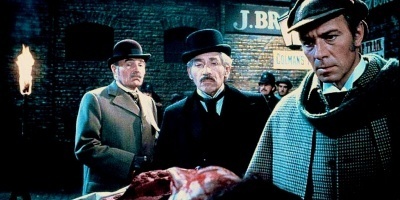
Sherlockian.net recently announced a new project entitled “Spiritualizing Sherlock” wherein site proprietor Chris Redmond and Lindsay Colwell, a Sherlockian recently drawn back into the fold, investigate the role of religion in the Canon: “If you have ever wondered whether Sherlock Holmes was a member of the Church of England, a Lutheran or a Zoroastrian, and (more important) if you have ever thought about a Sherlock Holmes tale and considered the religious and spiritual implications it contained, your proverbial prayers have been answered. Today we launch “Spiritualizing Sherlock: A Study of the Religious and Theological Themes in the World of Sherlock Holmes”. The purpose of the project is to make possible a systematic understanding of all the religious and theological matters that are explicit or implicit in the Holmes canon, and what we can learn from them. We will begin by casting as broad a net as possible, to include religious practices and institutions, theological ideas, and also moral teachings.” Plans are underway to compile and make available online a definitive bibliography of writings on Holmes and religion. “In a later stage, we hope to develop a synthesis of the information and ideas that appear through the bibliography and our discussions of it, and to demonstrate patterns of religious ideas associated with Sherlock Holmes, Arthur Conan Doyle, and the Sherlockian canon. This part of the project will, we hope, result in a published monograph or e-book that will be a real contribution to Sherlockian knowledge.” Redmond, a sometimes lay preacher, and Colwell, a theologian by training, bring the necessary enthusiasm and holy cred to a project that’s sure to edify and provoke, and will no doubt illuminate an under appreciated aspect of the Canon.
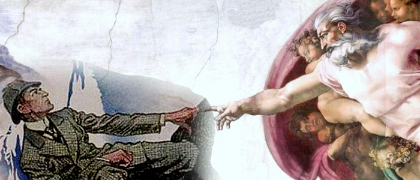
[The Great Detective and the Prime Mover tackle a little case called “The Adventure of Life”!]
Daily Dot ran a feature on everyone’s favorite all female Sherlock podcast The Baker Street Babes: ”“I also wanted to give a voice to young female fans. We’re poked fun at constantly by the media and those who don’t necessarily understand fan culture, but while we may have quirks and in-jokes, there’s an amazing level of scholarship and discussion happening. It’s always overlooked and I wanted the podcast to showcase both sides of the coin, if you will,” sayeth fearless leader of the Babes of Baker Street Kristina ‘Curly’ Manente. Along with the Babes’ usual Sherlockian podcast fun, make sure to check out their most recent episode reviews of CBS’s Elementary and the new Russian Sherlock Holmes.
[Kristina of the Baker Street Babes displaying her obvious sense of good taste and refinement via her choice of laptop stickers.]
reports on the newest baby naming phenomenon to sweep England: “Sherlock” has entered the list of top baby names for boys in England and Wales, after five families registered it in 2012….This isn’t the biggest rush on a baby name since time began but have you ever met someone called Sherlock? Exactly. Between 1996 and 2011 the detective’s name didn’t appear at all in the annual lists of top baby names for boys compiled by the Office For National Statistics….But once a name has been registered more than twice, it makes the cut. For Sherlock, that year was 2012, when it ended up 3,416th on a list of 4,805 male names, in the company of Ulysses, Roland and Timofey, which (among many others) also racked up five registrations apiece.” (Thanks to Jack Wilson+ for the tip!)
The Consulting Detective makes the case for “Why Murder By Decree (1979) Is Perfect.” Featuring 's second outing as Holmes - he first appeared as the Great Detective in a 1977 TV adaptation of Silver Blaze (an under-appreciated though excellent adaptation) - and accompanied by James Mason as Watson, Murder By Decree is both a typical and atypical 1970s-era Holmes adaptation which pits the Great Detective against Whitechapel’s most notorious denizen, Saucy Jack. Noting that Murder By Decree was not the first Sherlock vs. Jack the Ripper film - that honor goes to A Study In Terror (1965) featuring John Neville as Holmes and Donald Houston as Watson - “it features a far darker plot, draws off of real events and characters and features one of the finest yet controversial portrayals of Sherlock Holmes….Much like The Private Life of Sherlock Holmes (1970) and The Seven-Per-Cent Solution (1979) there is something very different about this version of Sherlock Holmes. Christopher Plummer’s Holmes is a kindhearted, very sincere man, at odds with the cold, calculating genius portrayed in Arthur Conan Doyle’s originals…Holmes still manages to unravel a tangled skein of events surrounding the Ripper murders, but he feels far more empathy towards all those involved.” The 1970s was not only a boom time for Sherlock Holmes, but it was a time when (Sherlockian and non-Sherlockian) writers and directors alike felt free to reinterpret and reanalyze the life and times as well as the psychology of a character whom many, until that time, had assumed inhabited an unbreakable mold. Murder By Decree certainly broke that mold - to positive effect - and for that reason alone certainly deserves a place in the upper echelons of great Holmes cinema.
[Nick Cardillo of The Consulting Detective proclaims: ”Murder by Decree is one of my favourite Sherlock Holmes films. It is by far one of the most brilliant Sherlock Holmes films I have ever seen, and perhaps one of my favourite movies in general. It is in my opinion essential viewing for any Sherlockian.”]
Fitzrovia News, a blog based out of London, recounts a recent trip to The Sherlock Holmes Museum of London: “If you’re looking for a fun activity, in the City of Westminster, this festive period, then why not pop along to the home of Sherlock Holmes. My friend and I didn’t even know that this quaint little museum existed but after dodging the dreaded Madame Tussauds’ queue, we looked up where else we could go in the area. In comparison, the queue to the Sherlock Holmes Museum was long but moved very quickly and we were soon inside the warm, Georgian house, for only £8 I may add.” Famous for it’s recreation of the sitting room at 221B as well as a menagerie of life sized, wax Canonical characters and fascinatingly detailed dioramas (Evil exalted on the Moor…in miniature!), I don’t know of a single Sherlockian who has visited the Museum and not come away amused by the displays. Where else on Earth can you meet a suspiciously literate beggar with a twisted lip, watch as the hand of justice cuts down "the worst man in London" and look into the eyes of the Napoleon of Crime?
[Everyone’s favorite New Jersey native and adventuress with the hereditary King of Bohemia from SCAN immortalized in wax at The Sherlock Holmes Museum on Baker Street. Photo by Atomly.]
The Saturday Review of Literature, edited by Donald Pollock and friends, announced that SRL 2014, Issue No. 2 will be “published on January 18, 2014. Copies can be ordered in advance for $5.00 (which includes postage) to: Donald Pollock 521 College Ave. Niagara Falls, NY 14305….We can promise something of interest, if not outrage, for everyone. Copies will be mailed out following the BSI Weekend, though I am happy to bring along to New York copies for anyone who orders in advance.”
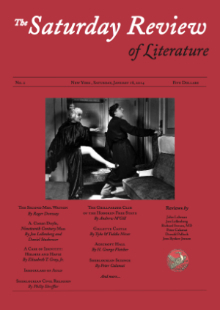
[The cover for Issue 2 of The Saturday Review of Literature.]
Quick Sherlock Links:
Den of Geek reports on BBC Worldwide’s announcement of a special edition BBC Sherlock box set. Limited to 3000 units, each set will contain all three series of Sherlock on disc as well as a copy of an episode script from the first series penned by Steven Moffat, a letter from a “popular returning character” and a soft touch A6 size notebook all housed in the poshest of packages. (Thanks to IHOSE for the tip!)
Wales Online looks at 20 TV ‘bromances’ to rival BBC Sherlock's Holmes and Watson. If you're unfamiliar with what a “bromance" is "a close non-sexual relationship between two (or more) men, a form of affectional or homosocial intimacy," cf. buddy film, male bonding or any BBC Sherlock scene featuring just Sherlock and John.
Mirror announces BBC Sherlock mini episode Many Happy Returns to air on Christmas Day in the UK. I’ve been attempting to remain un-spoiled so you’ll have to follow the link for more details. On a related note, deerstalkers off to the BBC promotions department for how they announced the UK air date of the Series 3 premier: driving an old fashioned hearse around St Barts adorned with the words “Sherlock” and the air date and then parking in front of the now infamous ‘red Sherlock phone box’.
[Click for larger view, but the floral arrangement spells out “Sherlock 01-01-14.”]
Dan Andriacco in “Those Creepy, Serpentine Master Criminals” points out the “herpetological similes” which Holmes applied to Moriarty as well as “the worst man in London” and master blackmailer Charles Augustus Milverton.
Doyleockian looks at speculation surrounding Holmes’ retirement in “Sherlock Holmes post 1903 - the Bee-keeping Years”. “The subject of Sherlock Holmes’s retirement is one as open to speculation as the great hiatus. In fact, you could argue, that they are much the same. They are periods when Holmes’s movements are largely unknown.” So just what was Holmes up to between the two mystery periods of “December 1903 - July 1907 and 1907 (post Lion’s Mane) to August(ish) 1912?” A truly fascinating hole in the world of Sherlockian studies.
The Bootmakers of Toronto - the legendary Sherlock Holmes Society Canada - have recently joined the Sherlockian Twitterverse with @BootmakersTO as well as announcing a reboot of their official website TorotnoBootmakers.com. And don’t forget to download for free the latest issue of the Bootmaker’s journal, Canadian Holmes (Vol.36 No.1, Fall 2013) in either epub or PDF format. Standout articles this issue include “Sherlock Holmes in ‘The Hands of the Jews:’ Jewish Stereotypes in the Canon”, “The Victorian Concept of Honour in The Bruce-Partington Plans” and “Science and Sherlock Holmes”.
[Cover for the Fall 2013 edition of Canadian Holmes (Vol.36 No.1).]
Sidgwicks celebrates December with the discovery of this bold and wonderful scene featuring Holmes and Watson traipsing through London in an attempt to discover just how the “bonniest, brightest little blue egg that ever was seen” ended up in the crop of an Xmas goose. Russian illustrator Adrian Yermolayev created this Christmas scene without slush (to paraphrase Kit) in order to accompany “The Adventure of the Blue Carbuncle” from a Soviet-era collection of Holmes favorites titled The Red-Headed League and Other Stories (Saint Petersburg: Detgiz, 1945).
[Holmes and Watson in “The Adventure of the Blue Carbuncle.”]





